
- •Foreword
- •Contents
- •Preface
- •List of Contributors
- •1 Synthetic Approaches to Metallic Nanomaterials
- •2 Synthetic Approaches for Carbon Nanotubes
- •3 Nanostructured Systems from Low-Dimensional Building Blocks
- •4 Nanostructured Collagen Mimics in Tissue Engineering
- •6 Electron Microscopy Techniques for Characterization of Nanomaterials
- •7 X-Ray Methods for the Characterization of Nanoparticles
- •8 Single-Molecule Detection and Manipulation in Nanotechnology and Biology
- •9 Nanotechnologies for Cellular and Molecular Imaging by MRI
- •10 Nanotechnology in Nonviral Gene Delivery
- •11 Nanoparticles for Cancer Drug Delivery
- •12 Diagnostic and Therapeutic Applications of Metal Nanoshells
- •13 Decorporation of Biohazards Utilizing Nanoscale Magnetic Carrier Systems
- •14 Nanotechnology in Biological Agent Decontamination
- •15 Too Small to See: Educating the Next Generation in Nanoscale Science and Engineering
- •Index

3
1
Synthetic Approaches to Metallic Nanomaterials
Ryan Richards and Helmut B.nnemann
1.1
Introduction
In recent years research involving nanoparticles and nanoscale materials has generated a great deal of interest from scientists and engineers of nearly all disciplines. This interest has been generated in large part by reports that a number of physical properties including optical and magnetic properties, specific heats, melting points, and surface reactivities are size-dependent. These size-dependent properties are widely believed to be a result of the high ratio of surface to bulk atoms as well as the bridging state they represent between atomic and bulk materials. In the nanoscale regime, materials (especially metals and metal oxides) can be thought of as neither atomic species which can be represented by well defined molecular orbitals, nor as standard bulk materials which are represented by electronic band structures, but rather by size-dependent broadened energy states. Because metallic particles are of great importance industrially, an understanding of their properties from small clusters to bulk materials is essential. Although these nanoscale colloidal metals are of interest to scientists of many disciplines, methods for their preparation and chemical applications are primarily the focus of chemists.
Originally called gold sols, colloidal metals first generated interest because of their intensive colors, which enabled them to be used as pigments for glass or ceramics. Nanoparticulate metal colloids are generally defined as isolable particles between 1 and 50 nm in size that are prevented from agglomerating by protecting shells. Depending on the protection shell used they can be redispersed in water (“hydrosols”) or organic solvents (“organosols”). The number of potential applications for these colloidal particles is growing rapidly because of the unique electronic structure of the nanosized metal particles and their extremely large surface areas. A considerable body of knowledge has been gained about these materials throughout the last few decades, and the reader is directed to the numerous books and review articles in the literature which cover these subjects in detail [1–12, 19–26]. This contribution will be focused towards presenting an overview of the synthetic methods used to prepare metallic nanomaterials, factors influencing size and shape, and a survey of potential applications in materials science and biology. Although not covered here, the area of biodirected syntheses is an emerging area of extreme interest [13–18].
Nanofabrication Towards Biomedical Applications. C. S. S. R. Kumar, J. Hormes, C. Leuschner (Eds.) Copyright 2005 WILEY-VCH Verlag GmbH & Co. KGaA, Weinheim
ISBN 3-527-31115-7
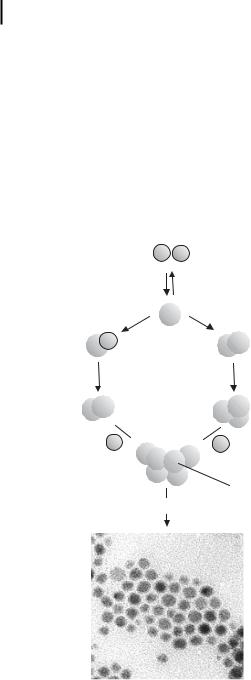
41 Synthetic Approaches to Metallic Nanomaterials
1.2
Wet Chemical Preparations
Nanostructured metal colloids have been obtained by both the so-called “top down” and “bottom up” methods. A typical “top down” method for example involves the mechanical grinding of bulk metals and subsequent stabilization of the resulting nanosized metal particles by the addition of colloidal protecting agents [27, 28]. Metal vapor techniques have also provided chemists with a very versatile route for the production of a wide range of nanostructured metal colloids on a preparative laboratory scale [29–34]. Use of metal vapor techniques is limited because the operation of the apparatus is demanding and it is difficult to obtain a narrow particle size distribution. The “bottom up” methods of wet chemical nanoparticle preparation rely on the chemical reduction of metal salts, electrochemical pathways, or the
M+ X-
Reduction Reoxidation
M+
autocatalytical |
|
Collision of Metal |
|
Nucleation |
Atoms |
||
Pathway |
|||
|
|||
|
|
M+ 

 M+
M+
Stable Nucleus
(irreversible)
Growth
nanostructured metal colloid (TEM Micrograph)
Figure 1.1. Formation of nanostructured metal colloids via the “salt reduction” method. (Adapted from Ref. [4].)
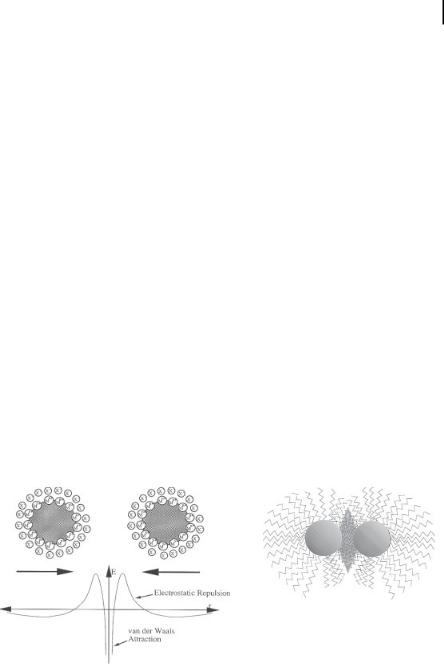
1.2 Wet Chemical Preparations 5
controlled decomposition of metastable organometallic compounds. A large variety of stabilizers, e.g., donor ligands, polymers, and surfactants, are used to control the growth of the primarily formed nanoclusters and to prevent them from agglomerating. The chemical reduction of transition metal salts in the presence of stabilizing agents to generate zerovalent metal colloids in aqueous or organic media was first published in 1857 by Faraday [35], and this approach has become one of the most common and powerful synthetic methods in this field [10, 11, 36]. The first reproducible standard recipes for the preparation of metal colloids (e.g., for 20 nm gold by reduction of [AuCl4–] with sodium citrate) were established by Turkevich [1–3]. Based on nucleation, growth, and agglomeration he also proposed a mechanism for the stepwise formation of nanoclusters which in essence is still valid. Data from modern analytical techniques and more recent thermodynamic and kinetic results have been used to refine this model as illustrated in Fig. 1.1 [31–38].
The metal salt is reduced to give zerovalent metal atoms in the embryonic stage of nucleation [37]. These can collide in solution with further metal ions, metal atoms, or clusters to form an irreversible “seed” of stable metal nuclei. Depending on the difference of the redox potentials between the metal salt and the reducing agent applied, and the strength of the metal–metal bonds, the diameter of the “seed” nuclei can be well below 1 nm.
Nanostructured colloidal metals require protective agents for stabilization and to prevent agglomeration. The two basic modes of stabilization which have been distinguished are electrostatic and steric (Fig. 1.2) [36]. Electrostatic stabilization [see Fig. 1.2(a)] involves the coulombic repulsion between the particles caused by the electrical double layer formed by ions adsorbed at the particle surface (e.g., sodium citrate) and the corresponding counterions. As an example, gold sols are prepared by the reduction of [AuCl4–] with sodium citrate [1–3]. By coordinating sterically demanding organic molecules that act as protective shields on the metallic surface, steric stabilization [Fig. 1.2(b)] is achieved. In this way nanometallic cores are separated
b
a
Figure 1.2. (a) Electrostatic stabilization of nanostructured metal colloids. (Scheme adapted from Ref. [36].) (b) Steric stabilization of nanostructured metal colloids. (Scheme adapted from Ref. [36].)

61 Synthetic Approaches to Metallic Nanomaterials
from each other, and agglomeration is prevented. The main classes of protective groups selected from the literature are: polymers and block copolymers [45–48]; P, N, S donors (e.g., phosphines, amines, thioethers) [6, 65–90]; solvents such as THF [6, 91], THF/MeOH [92], or propylene carbonate [93]; long chain alcohols [49–64, 94]; surfactants [6, 7, 9, 21, 22, 93, 95–106]; and organometallics [107–110]. In general, lipophilic protective agents give metal colloids that are soluble in organic media (“organosols”) while hydrophilic agents yield water-soluble colloids (“hydrosols”). In Pd organosols stabilized by tetraalkylammonium halides the metal core is protected by a monolayer of the surfactant coat (Fig. 1.3) [111].
Metal hydrosols, in contrast, are stabilized by zwitterionic surfactants which are able to self-aggregate, and are enclosed in organic double layers. After the application of uranylacetate as a contrasting agent, the transmission electron micrographs show that the colloidal Pt particles (average size = 2.8 nm) are surrounded by a double layer zone of the zwitterionic carboxybetaine (3–5 nm). The hydrophilic head group of the betaine interacts with the charged metal surface and the lipophilic tail is associated with the tail of a second surfactant molecule, resulting in the formation a hydrophilic outer sphere (see Fig. 1.4) [112]. Pt or Pt/Au particles can be hosted in the hydrophobic holes of nonionic surfactants, e.g., polyethylene monolaurate [113, 114].
Stabilizing Shell e.g. NR4+Br-
Metal Core
∆ ∆ = (dTEM - dSTM)/2
dTEM
dSTM
Figure 1.3. Differential transmission electron microscopy/ scanning transmission electron microscopy (TEM/STEM) study of a Pd organosol showing that the metal core
(size = dTEM) is surrounded by a monolayer of the surfactant (thickness D = (dTEM – dSTM)2). (Adapted from Ref. [9].)
1.3
Reducing Agents
The type of reducing agent employed has been found to greatly affect the resulting particles. It has been experimentally verified in the case of silver that stronger reducing agents produce smaller nuclei in the “seed” [37]. During the so-called “ripening”
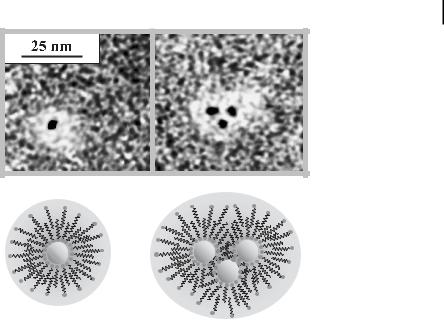
1.3 Reducing Agents 7
a
b
Figure 1.4. (a) TEM micrographs of colloidal Pt particles (single and aggregated, average core size = 2.8 nm) stabilized by carboxybetaine 12 (3–5 nm, contrasted with uranylacetate against the carbon substrate). (b) Schematic
model of the hydrosol stabilization by a double layer of the zwitterionic carboxybetaine
12 (= lipophilic alkyl chain; .vvvvv = hydrophilic, zwitterionic head group). (Adapted from Ref. [4].)
process these nuclei grow to yield colloidal metal particles in the size range of 1–50 nm which have a narrow size distribution. It was assumed that the mechanism for the particle formation is an agglomeration of zerovalent nuclei in the “seed” or – alternatively – collisions of already formed nuclei with reduced metal atoms. The stepwise reductive formation of Ag3+ and Ag4+ clusters by spectroscopic methods has been followed by Henglein’s group [38]. Their results strongly suggest that an autocatalytic pathway is involved in which metal ions are adsorbed and successively reduced at the zerovalent cluster surface. The formation of colloidal Cu protected by cationic surfactants (NR4+) has been investigated by in situ X-ray absorption spectroscopy which demonstrated the formation of an intermediate Cu+ state prior to the nucleation of the particles [41]. It is now generally accepted that the size of the resulting metal colloid is determined by the relative rates of nucleation and particle growth, although the processes taking place during nucleation and particle growth cannot be analyzed separately.
The salt reduction method has the main advantage that in the liquid phase it is reproducible and it allows colloidal nanoparticles with a narrow size distribution to be prepared on the multigram scale. The classical Faraday route via the reduction of [AuCl4]– with sodium citrate for example, is still used to prepare standard 20-nm gold sols for histological staining applications [1, 115]. Wet chemical reduction procedures have been applied in the last 20 years or so to combine practically all transi-

81 Synthetic Approaches to Metallic Nanomaterials
tion metals with different types of stabilizers, and the whole range of chemical reducing agents has successfully been applied. In 1981, Schmid et al. established the “diborane-as-reductant route” for the synthesis of Au55(PPh3)12Cl6 (1.4 nm), a full shell (“magic number”) nanocluster stabilized by phosphine ligands [57–72]. Clusters of Au55 were uniformly formed when a stream of B2H6 was carefully introduced into a AuIII ion solution. The “diborane route” for M55L12Cln nanoclusters was recently reviewed by Finke et al. [11]. Bimetallic nanoclusters that were made accessible by this method have been thoroughly characterized [65–80]. The phosphane ligands may be exchanged in the Au55 nanoclusters quantitatively using silsesquioxanes, which causes important changes in the physical and chemical behavior of the gold clusters [80]. The synthesis and general chemistry of nanosized silica-coated metal particles has been elaborated by Mulvaney et al. [80]. The “alcohol reduction process” described by Hirai and Toshima et al. [10, 45–48] is widely applicable to the preparation of colloidal precious metals stabilized by organic polymers such as poly(vinylpyrrolidone) (PVP), poly(vinyl alcohol) (PVA), and poly(methylvinyl ether). Alcohols containing a-hydrogen atoms are oxidized to the corresponding carbonyl compound (e.g., methanol to formaldehyde) during the salt reduction. The method for preparing bimetallic nanoparticles via the coreduction of mixed ions has been evaluated in a recent review [10]. Recently, it has been demonstrated that through the appropriate choice of reduction temperature and acetate ion concentration, ruthenium nanoparticles prepared by the reduction of RuCl3 in a liquid polyol could be monodispersely prepared with sizes in the 1–6 nm range [116]. Hydrogen has been used as an efficient reducing agent for the preparation of electrostatically stabilized metal sols and of polymer-stabilized hydrosols of Pd, Pt, Rh, and Ir [117–121]. Moiseev’s giant Pd cluster [Fig. 1.5(a)] [81–86], Finke’s polyoxoanion, and tetrabutyl- ammonium-stabilized transition-metal nanoclusters [Fig. 1.5(b)] [11, 40, 122–126] were also prepared by the hydrogen reduction pathway.
Finke et al. have recently reviewed the characterization of Moiseev’s “giant” cationic Pd clusters [81–86] [Fig. 1.5(a)] [idealized formula Pd»561L»60(OAc)»180 (L= phenanthroline, bipyridine)] and their catalytic properties [11]. The results of a combination of modern instrumental analysis methods applied to Finke’s nanoclusters have also recently been carefully discussed [11].
Using CO, formic acid or sodium formate, formaldehyde, and benzaldehyde as reductants, colloidal Pt in water [2, 127] was obtained [128]. Silanes have been found to be effective for the reductive preparation of Pt sols [129, 130]. Duff, Johnson, and Baiker et al. have successfully introduced tetrakis(hydroxymethyl)phosphoniumchloride (THPC) as a reducing agent, which allows the sizeand morphologyselective synthesis of Ag, Cu, Pt, and Au nanoparticles from their corresponding metal salts [131–136]. Further, hydrazine [137], hydroxylamine [138], and electrons trapped in, for example, K+[(crown)2K]– [139], have also been successfully applied as reductants. In addition, BH4– has been found to be a powerful and valuable reagent for the salt reduction method. A disadvantage, however, is that transition metal borides are often found along with the nanometallic particles [140, 141]. Tetraalkylammonium hydrotriorganoborates [6, 7, 9, 21, 95–97] offer a wide range of applications in the wet chemical reduction of transition metal salts. The reductant [BEt3H–] is
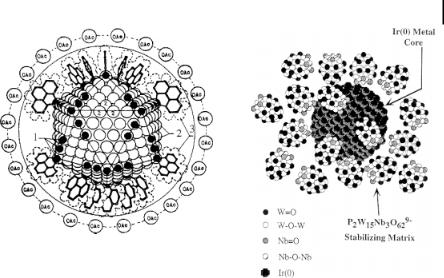
1.3 Reducing Agents 9
a
b
Figure 1.5. (a) Idealized model of Moiseev’s “giant palladium cluster” Pd»561Phen»60(OAc)»180 (Phen = phenanthroline) (adapted from Ref. [4]). (b) Idealized model of a Finke type Ir(0) nanocluster P2W15Nb3O629– – and Bu4N+-stabilized Ir(0)»300. (Adapted from Ref. [4].)
combined with the stabilizing agent (e.g. NR4+) in this case. The surface-active NR4+ salts are formed immediately at the reduction center at high local concentration and prevent particle aggregation. Trialkylboron is recovered unchanged from the reaction and there are no borides contaminating the products. Most recently it has been demonstrated that the chain length of the alkyl group in the tetraalkylammonium plays a critical role in the stabilization of various metal colloids [142].
MXm + NR4(BEt3H) ! Mcolloid + m NR4X + m BEt3 + m/2 H2 " |
(1) |
where M = metals of groups 6–11; X = Cl, Br; m= 1,2,3; and R = alkyl, C6–C20. The NR4+-stabilized metal “raw” colloids as synthesized typically contain 6–12 wt% of metal. “Purified” transition metal colloids containing ca. 70–85 wt% of metal are obtained by work-up with ethanol or ether and subsequent reprecipitation by a solvent of different polarity (see Tab. 9 in Ref. [6]). When NR4X is coupled to the metal salt prior to the reduction step the pre-preparation of [NR4+ BEt3H–] can be avoided. Transition metal nanoparticles stabilized by NR4+X– can also be obtained from NR4X-transition metal double salts. A number of conventional reducing agents may be applied since the local concentration of the protecting group is sufficiently high to give Eq. (2) [7, 21].
(NR4)w MXvYw + v Red ! Mcolloid + v RedX + w NR4Y |
(2) |
where M = metals; Red = H2, HCOOH, K, Zn, LiH, LiBEt3H, NaBEt3H, KBEt3H; X,Y = Cl, Br; v, w= 1–3 and R = alkyl, C6–C12.
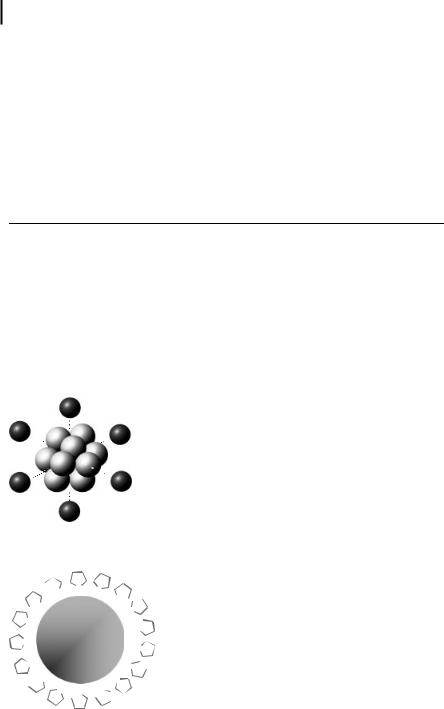
10 1 Synthetic Approaches to Metallic Nanomaterials
The scope and limitations of this method have been evaluated in a recent review [11]. Isolable metal colloids of the zerovalent early transition metals which are stabilized only with THF have been prepared via the [BEt3H–] reduction of the preformed THF adducts of TiBr4, [Eq. (3)] ZrBr4, VBr3, NbCl4, and MnBr2 [Eq. (3)].
x · [TiBr4 · 2 THF + x · 4 K[BEt3H] THF, 2h, 20 C (3)
!
[Ti · 0.5 THF]x + x · 4 BEt3 + x · 4 KBr# + x · 4 H2"
The results are summarized in Tab. 1.1.
Table 1.1. THF-stabilized organosols of early transition metals.
Product |
Starting material |
Reducing agent |
T |
T |
Metal content |
Size |
|
|
|
( C) |
(h) |
(%) |
(nm) |
|
|
|
|
|
|
|
[Ti · 0.5THF] |
TiBr4 · 2THF |
K[BEt3H] |
rt |
6 |
43.5 |
(<0.8) |
[Zr · 0.4THF] |
ZrBr4 · 2THF |
K[BEt3H] |
rt |
6 |
42 |
– |
[V · 0.3THF] |
VBr3 · 3THF |
K[BEt3H] |
rt |
2 |
51 |
– |
[Nb . 0.3THF] |
NbCl4 · 2THF |
K[BEt3H] |
rt |
4 |
48 |
– |
[Mn · 0.3THF] |
MnBr2 · 2THF |
K[BEt3H] |
50 |
3 |
70 |
1–2.5 |
Detailed studies of [Ti · 0.5 THF] [91] show that it consists of Ti13 clusters in the zerovalent state, stabilized by six intact THF molecules (Fig. 1.6).
O
O 
 O
O
Ti
O O
O
Figure 1.6. Ti13 cluster stabilized by six THF-O atoms in an octahedral configuration [7].
 S S S
S S S
S

 S
S
S
S
S
S Colloid Particle
S
S S 
 S S
S S
S  S
S  S
S 
Figure 1.7. Organosols stabilized by tetrahydrothiophene. For M = Ti, V: decomposition. For M= Mn, Pd, Pt: stable colloids.
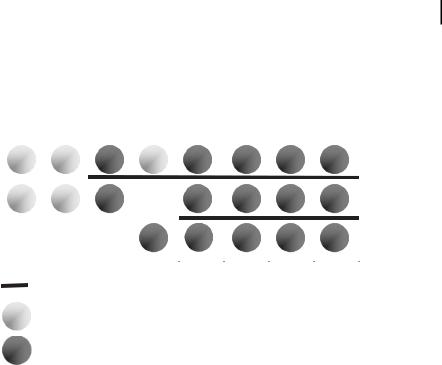
1.3 Reducing Agents 11
By analogy, [Mn · 0.3 THF] particles (1–2.5 nm) were prepared [143] and the physical properties studied [144]. In the case of Mn, Pd, and Pt organosols the THF in Eq. (3) was successfully replaced by tetrahydrothiophene (THT); but attempts to stabilize Ti and V this way led to decomposition (Fig. 1.7) [7].
Figure 1.8 gives an overview of the [BEt3H–] method. The advantages of this method may be summarized as follows:
Ti |
V |
Cr |
Mn |
Fe |
Co |
Ni |
Cu |
|
<0.8 |
3.0 |
1-2.5 |
3.0 |
2.8 |
2.8 |
8.3 |
||
|
||||||||
|
|
|
|
|
|
|
|
|
Zr |
Nb |
Mo |
|
Ru |
Rh |
Pd |
Ag |
|
2-3 |
|
1.3 |
2.1 |
2.5 |
2-13 |
|||
|
|
|
||||||
|
|
|
|
|
|
|
|
|
|
|
|
Re |
Os |
Ir |
Pt |
Au |
|
|
|
|
1.5 |
2.8 |
10 |
|||
|
|
|
|
|
||||
|
|
|
|
|
|
|
|
Nanometal powders
THF-stabilized nanometals
NR4+-stabilized nanometals
Figure 1.8. Nanopowders and nanostructured metal colloids accessible via the [BEt3H–] reduction method (including the mean particle sizes obtained). (Adapted from Ref. [7].)
. |
The method is generally applicable to salts of metals in groups 4–11 in the |
|
periodic table. |
. |
It yields extraordinarily stable metal colloids that are easy to isolate as dry |
|
powders. |
. |
The particle size distribution is nearly monodisperse. |
. |
Bimetallic colloids are easily accessible by coreduction of different metal |
|
salts. |
. |
The synthesis is suitable for multigram preparations and easy to scale up. |
One of the drawbacks of this method, however, is that the particle size of the resulting sols cannot be varied by altering the reaction conditions. Using betaines instead of NR4+ salts as the protecting group in Eq. (1), highly water-soluble hydrosols, particularly those of zerovalent precious metals, were made accessible. A wide variety of hydrophilic surfactants may be used in Eq. (2) [7, 21, 96]. Reetz and Maase et al. have reported a new method for the sizeand morphology-selective preparation of metal colloids using tetraalkylammonium carboxylates of the type NR4+R’CO2– (R = octyl, R¢ = alkyl, aryl, H) both as the reducing agent and the stabilizer [Eq. (4)] [145–147].
M+ + R4N+ R¢CO2– 50 – 90 C M0 (R4 NR¢CO2)x + CO2 + R¢-R |
(4) |
! |
|

12 1 Synthetic Approaches to Metallic Nanomaterials
where R = octyl, R¢= alkyl, aryl, H. The resulting particle sizes were found to correlate with the electronic nature of the R¢ group in the carboxylate. Electron donors produce small nanoclusters while electron-withdrawing substituents R¢, in contrast, yield larger particles. For example, Pd particles of 2.2 nm size were found when Pd(NO3)2 was treated with an excess of tetra(n-octyl)ammonium-carboxylate bearing R¢ = (CH3)3CCO2– as the substituent. The particle size was found to be 5.4 nm with R¢ = Cl2CHCO2– (an electron-withdrawing substituent). Bimetallic colloids of the following were obtained with tetra(n-octyl) ammonium formiate as the reductant: Pd/Pt (2.2 nm), Pd/Sn (4.4 nm), Pd/Au (3.3 nm), Pd/Rh (1.8 nm), Pt/Ru (1.7 nm), and Pd/Cu (2.2 nm). The shape of the particles was also found to depend on the reductant: with tetra(n-octyl) ammonium glycolate reduction of Pd(NO3)2 a significant amount of trigonal particles were detected in the resulting Pd colloid. Recent work in our group has shown that organoaluminum compounds can be used for the “reductive stabilization” of monoand bimetallic nanoparticles [see Eq. (5) and Tab. 1.2] [107–108].
Table 1.2. Monoand bimetallic nanocolloids prepared via the organo-aluminum route.
Metal salt |
Reducing agent |
|
Solvent |
Conditions |
Product |
Metal |
Particle |
||
|
|
|
|
Toluene |
|
|
|
content |
size |
|
|
|
|
|
|
|
|
wt.% |
|
|
g/mmol |
|
g/mmol |
ml |
t [ C] |
t [h] |
m [g] |
|
F [nm] |
|
|
|
|
|
|
|
|
|
|
Ni(acac)2 |
0.275/1 |
Al(i-but)3 |
0.594/3 |
100 |
20 |
10 |
0.85 |
Ni: 13.8 |
2–4 |
Fe(acac)2 |
2.54/10 |
Al(me)3 |
2.1/30 |
100 |
20 |
3 |
2.4 |
n.d. |
|
RhCl3 |
0.77/3.1 |
Al(oct)3 |
4.1/11.1 |
150 |
40 |
18 |
4.5 |
Rh: 8.5 |
2–3 |
|
|
|
|
|
|
|
|
Al: 6.7 |
|
Ag-decanoate 9.3/21.5 |
Al(oct)3 |
8.0/21.8 |
1000 |
20 |
36 |
17.1 |
Ag: 11.8 |
8–12 |
|
|
|
|
|
|
|
|
|
Al: 2.7 |
|
Pt(acac)2 |
1.15/3 |
Al(me)3 |
0.86/7.6 |
150 |
20 |
24 |
1.45 |
Pt: 35.8 |
2.5 |
|
|
|
|
|
|
|
|
Al: 15.4 |
|
PtCl2 |
0.27/1 |
Al(me)3 |
0.34/3 |
125 |
40 |
16 |
0.47 |
Pt: 41.1 |
2.0 |
|
|
|
|
|
|
|
|
Al: 15.2 |
|
Pd(acac)2 |
0.54/1.8 |
Al(et)3 |
0.46/4 |
500 |
20 |
2 |
0.85 |
Pd: 22 |
3.2 |
Pt(acac)2 |
0.09/0.24 |
|
|
|
|
|
|
Pt: 5.5 |
|
|
|
|
|
|
|
|
|
Al: 12.7 |
|
Pt(acac)2 |
7.86/20 |
Al(me)3 |
8.64/120 |
400 |
60 |
21 |
17.1 |
Pt: 20.6 |
1.3 |
Ru(acac)3 |
7.96/20 |
|
|
|
|
|
|
Ru: 10.5 |
|
|
|
|
|
|
|
|
|
Al: 19.6 |
|
Pt(acac)2 |
1.15/2.9 |
Al(me)3 |
0.86/12 |
100 |
60 |
2 |
1.1 |
Pt: 27.1 |
n.d. |
SnCl2 |
0.19/1 |
|
|
|
|
|
|
Sn: 5.2 |
|
|
|
|
|
|
|
|
|
Al: 14.4 |
|
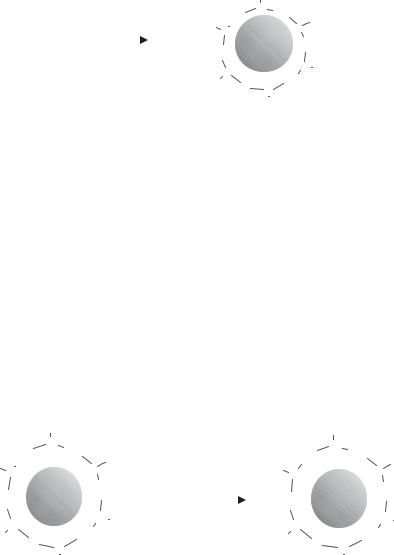
|
|
|
|
|
|
|
1.3 |
Reducing Agents |
13 |
|
|
|
|
|
CH3 |
|
|
|
|
|
|
|
|
|
|
|
|
|
|
|
|
|
|
acac |
Al acac |
|
CH3 |
|
|
|
Toluene |
H3C |
|
Al |
|
|
|||
|
Al |
|
|
|
|||||
MXn + AlR3 |
|
|
|
|
acac |
+ [R2Alacac] |
|||
|
acac |
|
|
|
|||||
|
|
|
|
||||||
|
|
|
|
Al CH |
|
|
|||
|
|
|
|
Al |
|
|
|
||
|
|
H3C |
|
acac |
|
3 |
(5) |
|
|
|
|
|
acac |
|
|
|
|||
|
|
|
Al |
|
|
|
|
||
|
|
|
|
|
|
|
|
||
CH3
M = Metals of Groups 6-11 PSE
X = Halogen, Acetylacetonate n = 2-4
R = C1-C8-Alkyl
Particle sizes 1-12nm
where M = metals of groups 6–11; X = halogen, acetylacetonate, n= 2–4; R = C1–C8- alkyl; particle sizes 1–12 nm.
Colloids of zerovalent elements of groups 6–11 of the periodic table (and also of tin) may be prepared according to Eq. (5), in the form of stable, isolable organosols. The analytical data available suggest that a layer of condensed organoaluminum species protects the transition metal core against aggregation as visualized in Eq. (5). The exact nature of the “backbone” of the colloidal organoaluminum protecting agent has not yet been completely established.
Quantitative protonolysis experiments have detected the presence of unreacted organoaluminum groups (e.g., Al–CH3, Al–C2H5) from the starting material which are still present in the stabilizer. These active Al–C bonds have been used for controlled protonolysis by long-chain alcohols or organic acids (“modifiers”) to give alalkoxide groups in the stabilizer [Eq. (6)].
|
|
CH3 |
|
|
|
|
|
OR |
|
|
acac |
Al acac |
|
CH3 |
|
|
acac |
Al acac |
OR |
H3C |
Al |
|
RO |
Al |
|||||
Al |
acac |
+ R-OH (Modifier) |
Al |
acac |
|||||
|
|
|
|
|
|
|
|||
|
|
|
|
|
|
|
|
|
|
acac |
|
|
|
|
|
acac |
|
|
|
|
|
Al CH |
- CH4 |
|
Al OR |
||||
|
Al |
|
|
|
Al |
||||
H3C |
acac |
|
3 |
|
RO |
acac |
|
||
acac |
|
|
|
acac |
|
||||
Al |
|
|
|
Al |
|
||||
|
|
|
|
|
|
||||
|
|
CH3 |
|
|
|
|
|
OR |
(6) |
|
|
|
|
|
|
|
|
|
|
Modifiers: alcohols, carbonic acids, silanols, sugars, polyalcohols, polyvinylpyrrolidone, surfactants, silica, alumina, etc.
The dispersion characteristics of the original sol can be tailored by this “modification” [Eq. (6)] of the organoaluminum protecting shell. A wide variety of dissolubilities of the colloidal metals in hydrophobic and hydrophilic media (including water) has been achieved this way. The active Al–C bonds in the colloidal protecting shell

14 1 Synthetic Approaches to Metallic Nanomaterials
can react with inorganic surfaces bearing –OH, which opens new ways for the heterogeneous catalyst preparation. The particle size of the metal core is not altered during this modification process (Fig. 1.9) [109].
Particle size distribution:(CH3)2-Alacac Pt/Ru-colloid |
Particle size distribution:modified Pt/Ru-colloid |
||||||||||||||||||||
50 |
|
|
|
|
|
|
|
|
|
|
50 |
|
|
|
|
|
|
|
|
|
|
|
|
|
|
|
|
|
|
|
|
|
|
|
|
|
|
|
|
|
|
||
|
|
|
|
|
|
|
|
|
|
|
|
|
|
|
|
|
|
|
|
|
|
40 |
|
|
|
|
|
|
|
|
|
|
40 |
|
|
|
|
|
|
|
|
|
|
|
|
|
|
|
|
|
|
Modifier |
|
|
|
|
|
|
|
|
|
|
|||
30 |
|
|
|
|
|
|
|
|
|
|
|
|
|
|
|
|
|
|
|||
|
|
|
|
|
|
|
|
|
|
30 |
|
|
|
|
|
|
|
|
|
|
|
|
|
|
|
|
|
|
|
|
|
|
|
|
|
|
|
|
|
|
|
|
|
20 |
|
|
|
|
|
|
|
|
|
|
20 |
|
|
|
|
|
|
|
|
|
|
|
|
|
|
|
|
|
|
|
|
|
|
|
|
|
|
|
|
|
|
|
|
10 |
|
|
|
|
|
|
|
|
|
|
10 |
|
|
|
|
|
|
|
|
|
|
|
|
|
|
|
|
|
|
|
|
|
|
|
|
|
|
|
|
|
|
|
|
0 |
|
|
|
|
|
|
|
|
|
|
0 |
|
|
|
|
|
|
|
|
|
|
|
|
|
|
|
|
|
|
|
|
|
|
|
|
|
|
|
|
|
|
||
0 |
1 |
2 |
3 |
4 |
5 |
6 |
7 |
8 |
|
|
|
|
|
|
|
|
|
|
|
|
|
|
|
0 |
1 |
2 |
3 |
4 |
5 |
6 |
7 |
8 |
|
||||||||||
|
|
|
|
|
|
|
|
|
|
|
|
||||||||||
[nm] |
[nm] |
|
Figure 1.9. Size conservation of colloidal Pt/Ru particles under the hydrophilic modification of the (CH3)n–Alacac protecting shell using polyethyleneglycol-dodecylether.
1.4
Electrochemical Synthesis
Since 1994 this very versatile preparation route for nanostructured monoand bimetallic colloids has been further developed by Reetz and his research group [8, 98, 99]. The overall process of electrochemical synthesis [Eq. (7)] can be divided into six elementary steps (see Fig. 1.10).
Anode: |
n+ |
|
– |
|
Mbulk |
! |
Mn+ + ne– |
|
Cathode: M |
|
+ |
ne |
+ |
stabilizer |
! |
Mcoll/stabilizer |
(7) |
Sum: |
Mbulk |
+ |
stabilizer |
! |
Mcoll/stabilizer |
|
||
1.Oxidative dissolution of the sacrificial Metbulk anode
2.Migration of Metn+ ions to the cathode
3.Reductive formation of zerovalent metal atoms at the cathode
4.Formation of metal particles by nucleation and growth
5.Arrest of the growth process and stabilization of the particles by colloidal protecting agents, e.g., tetraalkylammonium ions
6.Precipitation of the nanostructured metal colloids.
Advantages of the electrochemical pathway are that contamination with byproducts resulting from chemical reduction agents is avoided, and that the products are easily isolated from the precipitate. The electrochemical preparation also provides size-selective particle formation. Experiments using Pd as the sacrificial anode in the electrochemical cell to give (C8H17)4N+Br+-stabilized Pd(0) particles indicate that the particle size depends on the current density applied: high current densities led to small Pd particles (1.4 nm); low current densities, in contrast, gave larger particles (4.8 nm) [98]. As was seen in a careful analysis of tetraalkylammonium-stabilized Pd
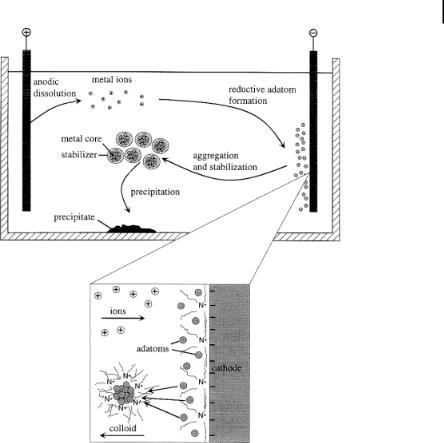
1.4 Electrochemical Synthesis 15
Figure 1.10. Electrochemical formation of NR4+Cl–-stabilized nanometal. (Adapted from Ref. [9].)
and Ni with a combination of transmission electron microscopy (TEM) and small angle X-ray scattering (SAXS), particle size is not controlled by a single cause but rather can be adjusted by varying the following parameters:
. |
The distance between the electrodes |
. |
The reaction time and temperature |
. |
The polarity of the solvent. |
Through the use of electrochemical synthesis nearly monodisperse Pd(0) particles with sizes between 1 and 6 nm can be obtained. It was also shown that the size of NR4+-stabilized Ni(0) particles [100] can be adjusted at will. The electrochemical method [98–105] [Eq. (7)] has been successfully applied to prepare a number of monometallic organosols and hydrosols, e.g., of Pd, Ni, Co, Fe, Ti, Ag, and Au on a scale of several hundred milligrams (yields >95%). Using the electrochemical pathway, solvent-stabilized (propylene carbonate) Pd particles (8–10 nm) have also been obtained [93]. If two sacrificial Metbulk anodes are used in a single electrolysis cell,

16 1 Synthetic Approaches to Metallic Nanomaterials
bimetallic nanocolloids (Pd/Ni, Fe/Co, Fe/Ni) are accessible [103]. In the cases of Pt, Rh, Ru, and Mo, which are anodically less readily soluble, the corresponding metal salts were electrochemically reduced at the cathode (see lower part of Fig. 1.10 and Tab. 1.3).
Table 1.3. Electrochemically prepared metallic colloids
Metal salt |
d(nm) |
Element analysis |
|
|
|
PtCl2 |
2.5b |
51.21% Pt |
PtCl2 |
5.0c |
59.71% Pt |
RhCl3 · x H2O |
2.5 |
26.35% Rh |
RuCl3 · x H2O |
3.5 |
38.55% Ru |
OsCl3 |
2.0 |
37.88%Os |
Pd(OAc)2 |
2.5 |
54.40% Pd |
Mo2(OAc)4 |
5.0 |
36.97% Mo |
PtCl2 + RuCl3 · xH20 |
2.5 |
41.79% Pt + 23.63% Rhd |
a Based on stabilizer-containing material. b Current density: 5.00 mA cm-2.
c Current density: 0.05 mA cm-2. d Pt-Ru dimetallic cluster.
Tetraalkylammonium-acetate was used both as the supporting electrolyte and the stabilizer in a Kolbe electrolysis at the anode [see Eq. (8)] [104].
Cathode: |
Pt2+ + 2e |
! |
Pt0 |
– |
(8) |
Anode: |
2 CH3CO2 |
! |
2 CH3CO2 |
+ 2e |
|
Bimetallic nanocolloids can be prepared by combining the electrochemical methods described in Eqs. (7) and (8) (see Tab. 1.4) [104].
Table 1.4. Bimetallic colloids prepared electrochemically
Anode |
Metal salt |
d(nm) |
Stoich. Energy disperse X-ray |
|
|
|
analysis |
|
|
|
|
Sn |
PtCl2 |
3.0 |
Pt50Sn50 |
Cu |
Pd(OAc)2a |
2.5 |
Cu44Pd56 |
Pd |
PtCl2 |
3.5 |
Pd50Pt50 |
a Electrolyte: 0.1M [(n-octyl)4N]OAc/THF.
By modifying the electrochemical method, the synthesis of layered bimetallic nanocolloids (e.g., Pt/Pd) was achieved [100, 105]. A preformed (Oct)4NBr-stabilized Pt colloid core (size: 3.8 nm) was electrolyzed in 0.1 M (Oct)4NBr/THF solution with Pd as the sacrificial anode (Fig. 1.11).
The preformed Pt core may be regarded as a “living metal polymer” on which the Pd atoms are deposited to give “onion-type” bimetallic nanoparticles (5 nm).
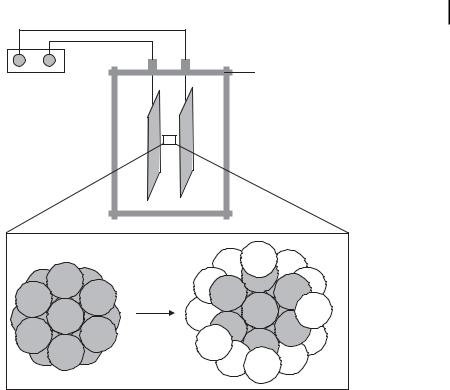
1.5 Decomposition of Low-Valency Transition Metal Complexes 17
+ |
_ |
|
|
|
Electrolysis Cell |
|
|
|
|
|
|
Electrolyte |
|
|
|
|
|
|
|
|
|
|
|
|
|
(0.1 M Oct4NBr/THF |
|
|
|
|
|
|
+ Oct4Br/Pt-Colloid) |
Pt-Cathode |
|
|
|
|
|
Pd-Anode |
|
|
|
|
|||
|
|
Pd |
Pt |
Pt |
|
Figure 1.11. Modified electrolysis cell for the preparation of layered bimetallic Pt/Pd nanocolloids. (Adapted from Ref. [100].)
1.5
Decomposition of Low-Valency Transition Metal Complexes
Short-lived nucleation particles of zerovalent metals in solution which may be stabilized by colloidal protecting agents are formed by decomposition of low-valency organometallic complexes and several organic derivatives of the transition metals under the action of heat, light, or ultrasound. Thermolysis [148–153], for example, leads to the rapid decomposition of Co carbonyls to give colloidal Co in organic solutions [148, 149]. Thermolysis of labile precious metal salts in the absence of stabilizers yields colloidal Pd, Pt, and bimetallic Pd/Cu nanoparticles [150] with a broad size distribution. In the presence of stabilizing polymers, such as PVP, these results were greatly improved [151]. Recently, heating in a simple household microwave oven was proposed to prepare nanosized metal particles and colloids [152, 153]. The electromagnetic waves heat the substrate uniformly, leading to more homogeneous nucleation and a shorter aggregation time.
Sonochemical decomposition methods have been successfully developed by Suslick et al. [154] and Gedanken et al. [155–157] and have yielded Fe, Mo2C, Ni, Pd, and Ag nanoparticles in various stabilizing environments.

18 1 Synthetic Approaches to Metallic Nanomaterials
By the controlled chemical decomposition of zerovalent transition metal complexes on the addition of CO or H2 in the presence of appropriate stabilizers, isolable yields of colloidal product in multigram amounts can be prepared [87–90, 158–168]. Bradley and Chaudret et al. [87–90, 159–165] have demonstrated the use of lowvalency transition metal olefin complexes as a very clean source for the preparation of nanostructured monoand bimetallic colloids. Micelles, inverse micelles, and encapsulation methods have also been successfully employed for the preparation of nanoparticulate colloids [38, 39, 94]. It is also worth mentioning that, although beyond the focus of this article, a number of nanoparticulate metal oxide systems have been successfully developed [7, 167–172].
The radiolytic synthesis of mixed Au(III)/Pd(II) solutions has been studied at different dose rates [173]. It was found that at low dose rates, a bilayered cluster with an Au core/Pd shell predominates due to intermetal electron transfer from Pd atoms to Au ions, resulting first in the reduction of the latter to form the core of the particle and then in Pd ion reduction to form the shell. However, at high dose rates when the ion reduction is faster than a possible intermetal electron transfer, genuine alloyed clusters are formed.
1.6
Particle Size Separations
When the particle size deviates less than 15% from the average value, metal colloid sols are generally addressed as “monodisperse.” Histograms with a standard deviation r from the mean particle size of approximately 20% are described as showing a “narrow size distribution.” The kinetics of the particle nucleation from atomic units and of the subsequent growth process cannot be observed directly by physical methods. The two primary tools available to the preparative chemist to control the particle size in practice are size-selective separation [51, 174, 175] and size-selective synthesis [41–56, 90, 135–137, 165–181].
So-called size-selective precipitation (SPP) was predominantly developed by Pileni [50]. Monodisperse silver particles (2.3 nm, r = 15%) were precipitated from a polydisperse silver colloid solution in hexane by the addition of pyridine in three iterative steps. Recently the two-dimensional “crystallization” of truly monodisperse Au55 clusters has been reported by Schmid et al. [174]. Chromatographic separation methods have thus far proven unsuccessful because the colloid was decomposed after the colloidal protecting shell had been stripped off [145]. C.lfen and Pauck have developed size-selective ultracentrifuge separation of Pt colloids [175]. However, although this elegant separation method gives true monodisperse metal colloids, it still provides only milligram-scale samples. Turkevich et al. were the first to describe size-selective colloid synthesis [1, 2]. They were able to vary the particle size of colloidal Pd between 0.55 and 4.5 nm using the salt reduction method. The crucial parameters were the amount of the reducing agent applied, and the pH value. According to the literature on the process of nucleation and particle growth, the essential factors which control the particle size are the strength of the metal–metal

1.6 Particle Size Separations 19
bond [48], the molar ratio of metal salt, colloidal stabilizer, reduction agent [1, 128, 135, 176–193], the extent of conversion or the reaction time [128], the temperature applied [1, 177, 189], and the pressure [177]. The preparation of nearly monodisperse nanostructured metal colloids using the salt reduction pathway is well documented in the literature. The “control,” i.e., the variation of particle sizes (and shapes), in wet chemical colloid synthesis in practice is left to the intuition of the chemist. At present the most rational method for selecting the particle size is offered by the electrochemical synthesis of Reetz and coworkers. The authors have obtained at will almost monodisperse samples of colloidal Pd and Ni between 1 and 6 nm using variable current densities and suitable adjustment of further essential parameters [98–105]. The resulting particle size in the thermal decomposition method depends on the heat source (see Tab. 1.5) [154]. Size control has also been reported for the sonochemical decomposition method and c-radiolysis [173, 194, 195].
Table 1.5. Platinum colloids prepared by thermal decomposition methods. (From Ref. [153]).
No.a |
PVPb |
Na0Hb |
Average |
Standard |
Relative |
|
|
|
diameter |
deviation |
standard |
|
|
|
(nm) |
(nm) |
deviation |
|
|
|
|
|
|
1 |
10 |
0 |
3.8 |
0.57 |
0.15 |
2 |
20 |
0 |
3.4 |
0.56 |
0.16 |
3 |
50 |
0 |
3.0 |
0.50 |
0.17 |
4 |
100 |
0 |
2.9 |
0.47 |
0.16 |
5 |
50 |
2 |
3.0 |
0.49 |
0.16 |
6 |
50 |
4 |
2.6 |
0.48 |
0.18 |
7 |
50 |
6 |
1.9 |
0.33 |
0.17 |
8 |
50 |
8 |
2.0 |
0.32 |
0.16 |
9 |
50 |
10 |
2.1 |
0.40 |
0.19 |
10 |
50 |
0 |
3.1 |
1.08 |
0.35 |
11 |
50 |
8 |
1.8 |
0.55 |
0.31 |
12 |
50 |
0 |
2.7 |
0.74 |
0.27 |
13 |
50 |
8 |
1.1 |
0.31 |
0.28 |
a Nos. 1–9 were prepared by microwave dielectric heating without stirring; nos. 10 and 11 were prepared without stirring, and nos. 12 and 13 were prepared with stirring by oil bath heating.
b Data refer to the molar ratios of PVP (as a monomeric unit) and NaOH to Pt respectively.
The domain of preparation methods using constrained environments affords control of the metal particle shape via the preformation of size and the morphology of the products in nano-reaction chambers [49–64]. Recently, the controlled tempera- ture-induced size and shape manipulation of 2- to 6-nm Au particles encapsulated in alkanethiolate monolayers has been reported [62]. The use of near-infrared laser light has induced an enormous increase in the size of thiol-passivated Au particles up to ca. 200 nm [62]. A new medium-energy ion scattering (MEIS) simulation pro-

20 1 Synthetic Approaches to Metallic Nanomaterials
gram has successfully been applied to the composition and average particle size analysis of Pt-Rh/a–Al2O3[63].
1.7
Potential Applications in Materials Science
It is expected that metal nanoparticles and their assemblies will have numerous applications in materials science. It has been demonstrated that physical properties including magnetic and optical properties, melting points, specific heats, and surface reactivity are size-dependent. Quantum size effects are related to the “dimensionality” of a system in the nanometer range. “Zero-dimensional” metal particles might still comprise hundreds of atoms. One-dimensional nanoparticle arrangements (cluster wires) are of potential practical interest as semiconducting nanopaths for applications in nanoelectronics. One-dimensional particle arrangements may be induced through host templates. Using vacuum or electrophoretic methods Schmid et al. [196–198] were able to fill the parallel channels of nanoporous alumina membranes with chains/rows of 1.4-nm Au particles giving one-dimensional “quantum wires” consisting of insulated 20to 100-Au55 clusters in a helical array. The diameter of the nanowire could be controlled by varying the pore size.
Interestingly, 1.4-nm Au particles were found to arrange themselves into a linear row when attached to single-stranded DNA oligonucleotides [199, 200]. Driven by the technological significance associated with such architectures, the fabrication of ordered two-dimensional nanoparticle arrays has been successfully achieved by several research groups whose work has recently been reviewed [201]. Planar arrays of uniform metal nanoparticles would allow the design of new “supercomputers” with a superior data storage capacity. Langmuir–Blodgett films of nanometal systems have frequently been studied in this respect. Starting with nanoparticles of defined nuclearity, two-dimensional lattices of thiolized Au55, Pd561, and Pd1415 have been made [202]. Recently, the first successful preparation of two-dimensional hexagonal and cubic lattices of Au55 nanoparticles by self-assembly on polymer films was reported [174]. Simply dipping polyethylenimine-modified surfaces into aqueous solutions of acid-functionalized Au55 cluster generates the Au55 monolayers shown in Fig. 1.12.
The interactions between the nanoparticles and the surface are obviously strong enough to prevent mechanical removal. Whereas the hexagonal form shown in Fig. 12 (a) is normal for an ordered monolayer, the cubic orientation seen in Fig. 12 (b) is unprecedented. Most of the work published on organized nanometal structures is focused on gold particles and sulfur-containing groups in the various ligands [203– 208]. Schiffrin et al. have achieved the self-organization of nanosized gold particles using NR4+X surfactants [209]. Ramos et al. have recently reported the surfactantmediated two-dimensional crystallization of colloidal crystals [210]. A potential new route to self-assembly of ordered colloidal structures is through the use of attractive Coulomb interactions between colloidal structures and surfactant structures. Nanostructured palladium clusters, stabilized by a monomolecular coat of tetraalkylam-
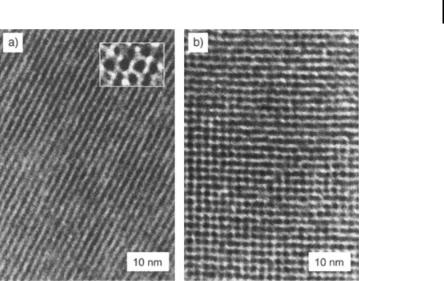
1.7 Potential Applications in Materials Science 21
a) |
|
b) |
|
|
|
10 nm |
|
10 nm |
|
|
|
Figure 1.12. Au55 monolayers showing a hexagonal (a) and a cubic (b) structure. The insert in (a) shows single clusters in the hexagonal form. (Adapted from Ref. [174].)
monium halide surfactants, self-assemble on carbon surfaces in an ordered manner with the formation of hexagonal close packed (hcp) structures [211–215].
The self-organization of magnetic nanosized cobalt particles was studied by Pileni’s group [216, 217]. A comparison of the magnetic properties of deposited cobalt nanoparticles with those dispersed in a solvent indicates a collective flip of magnetization of adjacent particles when they are self-assembled. Mulvaney et al. have described two-dimensional and three-dimensional assemblies of metal core–silica shell nanoparticles in a recent review article [218]. A feature article by Balazs et al. [219] outlines how solid additives can be used to tailor the morphology of binary mixtures containing nanoscopic particles and thereby control the macroscopic properties (e.g., the mechanical integrity) of composites. In addition, computer-aided design has been employed to establish how self-assembled nanostructures can be induced to form arbitrary functional designs on surfaces [220]. Bifunctional spacer molecules such as diamines have been used in attempts to link nanoparticles threedimensionally [221]. The multilayer deposition of particle arrays on gold has been successfully achieved via the sequential adsorption of dithiol and near-monodisperse nanometal or CdS particles.
Several monometal, bimetal, and metal-semiconductor superlattices have been prepared by dipping a gold substrate into the respective solutions with intermediate steps involving washing and drying [222]. The stepwise three-dimensional assembly of layered gold nanoparticles in porous silica matrices has also been reported [223].
A different field of technological interest stems from the high spin density of nanostructured magnetic metals of the Fe, Co, Ni series [224–225]. THF-stabilized Mn(0) particles which exhibit superparamagnetism below 20K were described as the first example of an antiferromagnetic metal colloid [226].
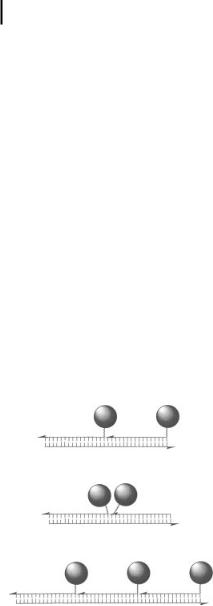
22 1 Synthetic Approaches to Metallic Nanomaterials
New strategies utilizing DNA as a construction material for the generation of biometallic nanostructures have made it possible to develop larger “nanotechnology devices” (<100 nm) for microelectronic photolithographic applications. DNA is regarded as a promising construction material for the selective positioning of molecular devices because of its recognition capabilities, physicochemical stability, and mechanical rigidity. Seeman was the first to propose DNA for the precise spatial arrangement of three-dimensional networks [227]. Assemblies of DNA-derivatized gold colloids were recently prepared via the DNA hybridization-based self-organiza- tion pathway and the resulting defined arrangements of nanometal particles have real applications in laser technology [228–231]. For example, Alivisatos et al. [199] have obtained defined mono-adducts from commercially available 1.4-nm gold clusters where one reactive maleimido group is attached to every particle. These were coupled with thiolated 18-mer oligonucleotides in order to add an individual “codon” sequence. When a single-stranded DNA template containing complementary codons is added, a self-assembly of nanocrystal molecules is observed (Fig. 1.13) [199, 232]. This work has been the subject of recent reviews [232–234].
Niemeyer et al. [233] have recently reported the coupling of metal particles bearing a biotin substituent with the DNA–streptavidin hybrid. The growth of a 12-mm- long, 100nm wide conductive silver wire has been achieved using a DNA molecule stretched between two gold electrodes as a template [235].
It remains to be seen how the practical applications of these materials will develop over the next few years.
a
b
c
Figure 1.13. Self-organization of conjugates from gold particles (shaded spheres) and oligonucleotide codons to supramolecular assemblies by the addition of a template strand. The derivatization of the oligonucleotides in 3¢ or 5¢
position allows control of the mode: head-to- head (a) or head-to-tail (b) homodimers. The trimer (c) is formed using the complementary sequence in triplicate. (Adapted from
Ref. [232].)

References 23
References
1J. Turkevich, P. C. Stevenson, J. Hillier, The nucleation and growth processes in the synthesis of colloidal gold (or is it coagulation of colloidal gold?), Disc. Faraday Soc. 1951, 11, 55–75.
2J. Turkevich, G. Kim, Palladium: preparation and catalytic properties of particles of uniform size, Science 1970, 169, 873.
3J. Turkevich, Colloidal gold. Part I. Historical and preparative aspects, morphology and structure, Gold Bulletin 1985, 18, 86–91.
4H. B.nnemann, R. Richards, Nanoscopic metal particles – synthetic methods and potential applications, Eur. J. Inorg. Chem. 2001, 2455–2480.
5 G. Schmid (ed.), Clusters and Colloids, VCH,
Weinheim, 1994.
6H. B.nnemann, W. Brijoux, R. Brinkmann, et al., Preparation, characterization, and application of fine metal particles and metal colloids using hydrotriorganoborates, J. Mol. Catal. 1994, 86, 129–177.
7H. B.nnemann, G. Braun, W. Brijoux, et al., Nanoscale colloidal metals and alloys stabilized by solvents and surfactants. Preparation and use as catalyst precursors, J. Organometallic Chem. 1996, 520, 143–162.
8M. T. Reetz, W. Helbig, S. A. Quaiser, Electrochemical methods in the synthesis of nanostructured transition metal clusters, in Active Metals, ed. A. F4rstner, VCH, Weinheim,
1996, 279–297.
9H. B.nnemann, R. Richards, Nanomaterials as precursors for electrocatalysis, in Catalysis and Electrocatalysis at Nanoparticle Surfaces, eds. A. Wieckowski, E. Sarinova, C. Vayenas, Marcel Dekker, New York, 2003
10N. Toshima, T. Yonezawa, Bimetallic nanoparticles – novel materials for chemical and physical applications, New J. Chem. 1998, 1179–1201.
11J. D. Aiken III, R. G. Finke, A review of modern transition-metal nanoclusters: their synthesis, characterization, and applications in catalysis, J. Mol. Catal. A 1999, 145, 1–44.
12K. Klabunde (ed.), Nanoscale Materials in Chemistry, Wiley Interscience, New York,
2001.
13E. Dujardin, S. Mann, Bio-inspired materials chemistry, Adv. Mater. 2002, 14, 775–788.
14M. Knez, A. Bittner, F. Boes, et al., Biotemplate synthesis of 3-nm nickel and cobalt nanowires, Nano Lett. 2003, 3(8), 1079–1082.
15E. Dujardin, C. Peet, G. Stubbs, et al., Organization of metallic nanoparticles using tobacco mosaic virus templates, Nano Lett. 2003, 3(3), 413–417.
16M. Reches, E. Gazit, Casting metal nanowires within discrete self-assembled peptide nanotubes, Science 2003, 300, 625–627.
17S. Behrens, K. Rahn, W. Habicht, et al., Nanoscale particle arrays induced by highly ordered protein assemblies, Adv. Mater. 2002,
14, 1621–1625.
18W. Shenton, T. Douglas, M. Young, et al., Inorganic-organic nanotube composites from template mineralization of tobacco mosaic virus, Adv. Mater. 1999, 11, 253–256.
19G. Schmid, in Applied Homogeneous Catalysis with Organometallic Compounds, eds.
B.Cornils, W. A. Herrmann, Wiley-VCH, Weinheim, 1996, 636–644, Vol. 2.
20W. A. Herrmann, B. Cornils, in Applied Homogeneous Catalysis with Organometallic Compounds, eds. B. Cornils, W. A. Herrmann, Wiley-VCH, Weinheim, 1996, 1171–1172, Vol. 2.
21H. B.nnemann, W. Brijoux, Surfactant-stabi- lized nanosized colloidal metals and alloys as catalyst precursors, in Advanced Catalysts and Nanostructured Materials, ed. W. Moser, Academic Press, San Diego, 1996, 165–196.
22H. B.nnemann, W. Brijoux, Potential applications of nanostructured metal colloids, in
Metal Clusters in Chemistry, eds.
P.Braunstein, L. A. Oro, P. R. Raithby, Wiley-VCH, Weinheim, 1999, 913–931, Vol. 2.
23T. J. Schmidt, M. Noeske, H. A. Gasteiger, et al., Electrocatalytic activity of PtRu alloy colloids for CO and CO/H2 electrooxidation: stripping voltammetry and rotating disk measurements, Langmuir 1997, 13, 2591–2595.
24E. Auer, W. Behl, T. Lehmann, U. Stenke (to
A.G. Degussa), CO tolerant anode catalyst for PEM fuel cells and method for its production, EP 09 24 784 A1 (June 23, 1999).
25M. G.tz, H. Wendt, Binary and ternary anode catalyst formulations including the elements W, Sn and Mo for PEMFCs operated on methanol or reformate gas, Electrochim. Acta 1998, 43, 3637–3644.

24 1 Synthetic Approaches to Metallic Nanomaterials
26 T. J. Schmidt, M. Noeske, H. A. Gasteiger, et al., PtRu alloy colloids as precursors for fuel cell catalysts. A combined XPS, AFM, HRTEM, and RDE study, J. Electrochem. Soc. 1998, 145, 925–931.
27E. Gaffet, M. Tachikart, O. El Kedim,
R.Rahouadj, Nanostructural materials formation by mechanical alloying: morphologic analysis based on transmission and scanning electron microscopic observations, Mater. Charact. 1996, 36, 185–190.
28A. Amulyavichus, A. Daugvila, R. Davidonis,
C.Sipavichus, Study of chemical composition of nanostructural materials prepared by laser cutting of metals, Fizika Metallov I Metallovedenie 1998, 85, 111–117.
29A. Schalnikoff, R. Roginsky, Eine neue Methode der Herstellung kolloider L.sungen, Z. Kolloid. 1927, 43, 67–70.
30J. R. Blackborrow, D. Young, Metal Vapor Synthesis, Springer-Verlag, New York, 1979.
31K. J. Klabunde, Free Atoms and Particles, Academic Press, New York, 1980.
32K. J. Klabunde, Y.-X. Li, B.-J. Tan, Solvated metal atom dispersed catalysts, Chem. Mater. 1991, 3, 30–39.
33J. S. Bradley, in Clusters and Colloids, ed.
G.Schmid, VCH, Weinheim, 1994, p. 477f.
34K. J. Klabunde, G. C. Cardenas-Trivino, in Active Metals, ed. A. F4rstner, VCH, Weinheim, 1996, 237–278.
35M. Faraday, The Bakerian lecture: experimental relations of gold (and other metals) to light, Philos. Trans. R. Soc. London 1857, 147, 145–153.
36J. S. Bradley, in Clusters and Colloids, ed.
G.Schmid, VCH, Weinheim, 1994, 469–473.
37T. Leisner, C. Rosche, S. Wolf, et al., The catalytic role of small-coinage clusters in photography, Surf. Rev. Lett. 1996, 3, 1105–1108.
38R. Tausch-Treml, A. Henglein, J. Lilie, Reactivity of silver in aqueous solution-2. pulse radiolysis study, Ber. Bunsen-Ges. Phys. Chem.
1978, 82, 1335–1343.
39M. Michaelis, A. Henglein, Reduction of Pd(II) in aqueous solution-stabilization and reactions of an intermediate cluster and Pd colloid formation, J. Phys. Chem. 1992, 96, 4719–4724.
40M. A. Watzky, R. G. Finke, Transition metal nanocluster formation kinetic and mechanistic studies. A new mechanism when hydrogen is the reductant: slow, continuous nucleation and fast autocatalytic surface growth,
J. Am. Chem. Soc. 1997, 119, 10382–10400.
41J. Rothe, J. Hormes, H. B.nnemann, et al., In situ X-ray absorption spectroscopy investigation during the formation of colloidal copper, J. Am. Chem. Soc. 1998, 120, 6019–6023.
42A.I. Kirkland, P.P Edwards, D.A. Jefferson, D.G. Duff, in Annual Reports on the Progress of Chemistry C, Royal Society of Chemistry, Cambridge, 1990, 247–305, Vol. 87.
43S. Ozkar, R. Finke, Transition-metal nanocluster stabilization fundamental studies: hydrogen phosphate as a simple, effective, readily available, robust, and previously unappreciated stabilizer for well-formed, isolable, and redissolvable Ir(0) and other transi- tion-metal nanoclusters, Langmuir 2003, 19, 6247–6260.
44B. Hornstein, R. Finke, Transition-metal nanocluster kinetic and mechanistic studies emphasizing nanocluster agglomeration: demonstration of a kinetic method that allows monitoring of all three phases of nanocluster formation and aging, Chem. Mater. 2004, 16, 139–150.
45H. Hirai, Y. Nakao, N. Toshima, K. Adachi, Colloidal rhodium in poly-vinylalcohol as hydrogenation catalyst of olefins, Chem Lett. 1976, 9, 905.
46H. Hirai, Y. Nakao, N. Toshima, Colloidal rhodium in poly(vinylpyrrolidone) as hydrogenation catalysts for internal olefins, Chem. Lett. 1978, 5, 545.
47H. Hirai, Y. Nakao, N. Toshima, Preparation of colloidal rhodium in polyvinyl alcohol by reduction with methanol, J. Macromol. Sci.
Chem. 1978, A12, 1117.
48H. Hirai, Y. Nakao, N. Toshima, Preparation of colloidal transition metals in polymers by reduction with alcohols or ethers, J. Macromol. Sci. Chem. 1979, A13, 727.
49J. Tanori, M.P. Pileni, Control of the shape of copper metallic particles by using a colloidal system as template, Langmuir 1997, 13, 639– 646.
50M. P. Pileni, Nanosized particles made in colloidal assemblies, Langmuir 1997, 13, 3266– 3276.

51M. Antonietti, C. G.ltner, Superstructures of functional colloids: chemistry on the nanometer scale, Angew. Chem. Int. Ed. Engl. 1997,
36, 911–928.
52M. P. Pileni, Colloidal self-assemblies used as templates to control size, shape and selforganization of nanoparticles, Supramol. Sci. 1998, 5, 321–329.
53M. P. Pileni, Self-organization of magnetic nanosized cobalt particles, Adv. Mater. 1998, 10, 259–261.
54M. Antonietti, Functional colloids: structure formation and chemistry on a nanometer scale, Chem.-Ing. Tech. 1996, 68, 518–523.
55S. F.rster, Ber. Bunsen-Ges. 1997, 101, 1671–1678.
56J. J. Storhoff, R. C. Mucic, C. A. Mirkin, Strategies for organizing nanoparticles into aggregate structures and functional materials,
J. Cluster Sci. 1997, 8, 179–216.
57M. M.ller, J. P. Spatz, Mineralization of nanoparticles in block copolymer micelles,
Curr. Opin. Colloid Interface Sci. 1997, 2, 177–187.
58G.B. Sergeev, M.A. Petrukhina, Encapsulation of small metal particles in solid organic matrixes, Prog. Solid State Chem. 1997, 24, 183–211.
59J.P. Wilcoxon, P. Provencio, Use of surfactant micelles to control the structural phase of nanosize iron clusters, J. Phys. Chem. B 1999, 103, 9809– 9812.
60T. Miyao, N. Toyoizumi, S. Okuda, et al., Preparation of Pt/SiO2 ultrafine particles in reversed micelles and their catalytic activity,
Chem. Lett. 1999, 10, 1125–26.
61S. T. Selvan, M. Nogami, A. Nakamura, Y. Hamanaka, A facile sol-gel method for the encapsulation of gold nanoclusters in silica gels and their optical properties, J. Non-Crys- talline Solids 1999, 255, 254–258.
62M. M. Maye, W. Theng, F. L. Leibowitz, et al., Heating-induced evolution of thiolate-encap- sulated gold nanoparticles: A strategy for size and shape manipulations, Langmuir 2000, 16, 490–497.
63Y. Niidome, A. Hori, T. Sato, S. Yamada, Enormous size growth of thiol-passivated gold nanoparticles induced by near-IR laser light, Chem. Lett. 2000, 4, 310–311.
References 25
64I. Konomi, S. Hyodo, T. Motohiro, Simulation of MEIS spectra for quantitative understanding of average size, composition, and size distribution of Pt-Rh alloy nanoparticles,
J.Catal. 2000, 192, 11–17.
65G. Schmid, R. Pfeil, R. Boese, et al., Au55[P(C6H5)3]12Cl6 a gold cluster of exceptional size, Chem. Ber. 1981, 114, 3634–3642.
66G. Schmid, Metal clusters and cluster metals, Polyhedron 1988, 7, 2321–2329.
67L. J. de Jongh, J. A. O. de Aguiar, H. B. Brom, et al., Physical properties of high nuclearity metal cluster compounds, Z. Phys. D. At. Mol. Clusters 1989, 12, 445–450.
68G. Schmid, B. Morum, J. Malm, Pt-309 a 4 shell platinum cluster, Angew. Chem. Int. Ed. Engl. 1989, 28, 778–780.
69G. Schmid, N. Klein, L. Korste, Large transition metal clusters, ligand exchange reactions
on Au55(PPh3)12Cl6 formation of a water soluble Au55 cluster, Polyhedron 1988, 7, 605–608.
70T. Tominaga, S. Tenma, H. Watanabe, et al., Tracer diffusion of a ligand-stabilized twoshell gold cluster, Chem. Lett. 1996, 12, 1033.
71G. Schmid, Large clusters and colloids-met- als in the embryonic state, Chem. Rev. 1992, 92, 1709–1727.
72H. A. Wicrenga, L. Soethout, I. W. Gerritsen, et al., Direct imaging of Pd561(phen)38+/– 2ON and Au55(PPh3)12Cl6 clusters using scanning tunnelling microscopy, Adv. Mater. 1990, 2, 482.
73R. Houbertz, T. Feigenspan, F. Mielke, et al.,
STM investigations on compact Au55 cluster pellets, Europhys. Lett, 1994, 28, 641.
74G. Schmid, A. Lehnert, The complexation of gold colloids, Angew. Chem. Int. Ed. Engl.
1989, 28, 780–781.
75G. Schmid, V. Maihack, F. Lantermann,
S.Peschel, Ligand stabilized metal clusters and colloids: properties and applications,
J.Chem. Soc. Dalton Trans. 1996, 589–595.
76G. Schmid, H. West, J.-O. Malm, et al., Catalytic properties of layered gold-palladium colloids, Chem. Eur. J. 1996, 2, 1099.
77U. Simon, R. Flesch, H. Wiggers, et al., Chemical tailoring of the charging energy in metal cluster arrangements by use of bifunctional spacer molecules, J. Mater. Chem. 1998, 8, 517–518.

26 1 Synthetic Approaches to Metallic Nanomaterials
78G. Schmid, S. Peschel, Preparation and scanning probe microscopic characterization of monolayers of ligand-stabilized transition metal clusters and colloids, New J. Chem. 1998, 22, 669–675.
79G. Schmid, R. Pugin, J.-O. Malm, J.-O. Bovin, Silsesquioxanes as ligands for gold clusters,
Eur. J. Inorg. Chem. 1998, 6, 813–817.
80M. Giersig, L. M. Liz-Tarzan, T. Ung, et al., Chemistry of nanosized silica-coated metal particles em study, Ber. Bunsenges. Phys.
Chem. 1997, 101,1617–1620.
81M. N. Vargaftik. V. P. Zargorodnikov ,
I.P. Stolarov, et al., Giant palladium clusters as catalysts of oxidative reactions of olefins and alcohols, J. Mol. Catal. 1989, 53, 315–349.
82M. N. Vargaftik, V. P. Zargorodnikov,
I.P. Stolyarov, et al., A novel giant palladium cluster, Chem. Commun. 1985, 14, 937–939.
83V. V. Volkov, G. Van Tendeloo, G. A. Tsirkov, et al., Longand short-distance ordering of the metal cores of giant Pd clusters, J. Cryst. Growth 1996, 163, 377.
84I. I. Moiseev, M. N. Vargaftik, V. V. Volkov, et al., Palladium 561 giant clusters – chemical aspects of self-organization on a nano level,
Mend. Commun. 1995, 3, 87–89.
85V. Oleshko, V. Volkov, W. Jacob, et al., High resolution electron microscopy and energy electron loss spectroscopy of giant palladium clusters, Z. Phys. D 1995, 34, 283.
86I. I. Moiseev, M. N. Vargaftik,
T.V. Chernysheva, et al., Catalysis with a palladium giant cluster: phenol oxidative carbonylation to diphenyl carbonate conjugated with reductive nitrobenzene conversion,
J.Mol. Catal. A: Chem. 1996, 108, 77.
87C. Amiens, D. de Caro, B. Chaudret,
J.S. Bradley, Selected synthesis, characterization and spectroscopic studies on a novel class of reduced platinum and palladium particles stabilized by carbonyl and phosphine ligands, J. Am. Chem. Soc. 1993, 115, 11638–11939.
88D. deCaro, H. Wally, C. Amiens, B. Chaudret, Synthesis and spectroscopic properties of a novel class of copper particles stabilized by triphenylphosphine, J. Chem. Soc., Chem. Comm. 1994, 16, 1891–1892.
89A. Rodriguez, C. Amiens, B. Chaudret, et al., Synthesis and isolation of cuboctahedral and icosahedral platinum nanoparticles. liganddependent structures, Chem. Mater. 1996, 8, 1978–1986.
90M. Bardaji, O. Vidoni, A. Rodriguez, et al., Synthesis of platinum nanoparticles stabilized by CO and tetrahydrothiophene. Facile conversion to molecular species, New
J.Chem. 1997, 21, 1243–1249.
91R. Franke, J. Rothe, J. Pollmann, et al.,
A study of the electronic and geometric structure of colloidal Ti0.0.5THF, J. Amer. Chem. Soc. 1996, 118, 12090–12097.
92O. Vidoni, K. Philippot, C. Amiens, et al., Broadening the aldolase catalytic antibody repertoire by combining reactive immunization and transition state theory: new enantioand diastereoselectivities, Angew. Chem. Int. Ed. Engl. 1999, 38, 3736–3738.
93M. T. Reetz, G. Lohmer, Propylene carbonate stabilized nanostructured palladium clusters as catalysts in Heck reactions, Chem. Commun. (Cambridge), 1996, 1921–1922.
94D. Mandler, I. Willner, Photohydrogenation of acetylenes in water oil 2-phase systemsapplication of novel metal colloids and mechanistic aspects of the process, J. Phys. Chem. 1987, 91, 3600–3605.
95U.S. Pat. 5,580,492 (Aug. 26, 1993),
H.B.nnemann, W. Brijoux, T. Joussen
(to Studiengesellschaft Kohle mbH).
96H. B.nnemann, W. Brijoux, R. Brinkmann, et al., Production of colloidal transition metals in organic phase and their use as catalysts, Angew. Chem. Int. Ed. 1991, 30, 1344–1346.
97U.S. Pat. 849,482 (Aug. 29, 1997),
H.B.nnemann, W. Brijoux, R. Brinkmann,
J.Richter (to Studiengesellschaft Kohle mbH).
98M. T. Reetz, W. Helbig, Size selective synthesis of nanostructured transition metal clusters, J. Am. Chem. Soc. 1994, 116, 7401–7402.
99U.S. Pat. 5,620,564 (Apr. 15, 1997) and U.S. Pat. 5,925,463 (Jul. 20, 1999), (M. T. Reetz,
W.Helbig, S. Quaiser (to Studiengesellschaft Kohle).
100M. A. Winter, PhD Thesis, 1998, Verlag Mainz, Aachen, ISBN 3–89653–355.

101J. A. Becker, R. Sch fer, W. Festag, et al., Electrochemical growth of superparamagnetic cobalt clusters, J. Chem. Phys. 1995, 103, 2520–2527.
102M. T. Reetz, S. A. Quaiser, C. Merk, Electrochemical preparation of nanostructured titanium clusters: Characterization and use in McMurry type coupling reactions, Chem. Ber. 1996, 129, 741–743.
103M. T. Reetz, W. Helbig, S. A. Quaiser, Electrochemical preparation of nanostructural bimetallic clusters, Chem. Mater. 1995, 7, 2227–2228.
104M. T. Reetz, S. A. Quaiser, Angew. Chem. 1995, 107, 2461–2463; A new method for the preparation of nanostructured metal clusters,
Angew. Chem. Int. Ed. Engl. 1995, 34, 2240.
105U. Kolb, S. A. Quaiser, M. Winter, M. T. Reetz, Investigation of tetraalkylammonium bromide stabilized palladium/platinum bimetallic clusters using extended X-ray absorption fine structure spectroscopy, Chem. Mater.1996, 8, 1889–1894.
106J. Kiwi, M. Gr tzel, Protection, size factors and reaction dynamics of colloidal redox catalysts mediating light induced hydrogen evolution from water, J. Am. Chem. Soc. 1979, 101, 7214–7217.
107H. B.nnemann, W. Brijoux, R. Brinkmann, et al., The reductive stabilization of nanometal colloids by organo-aluminum compounds,
Rev. Roum. Chim. 1999, 44, 1003–1010.
108J. Sinzig, L. J. De Jongh, H. B.nnemann, et al., Antiferromagnetism of colloidal [MN0.0.3THF]x, Appl. Organomet. Chem.,
1998, 12, 387–391.
109WO 99/59713 (November 25, 1999),
H.B.nnemann, W. Brijoux, R. Brinkmann (to Studiengesellschaft Kohle).
110J. S. Bradley, E. W. Hill, M. E. Leonowicz,
H.Witzke, Clusters, colloids and catalysis,
J. Mol. Catal. 1987, 41, 59–74.
111M. T. Reetz, W. Helbig, S. A. Quaiser, et al., Visualization of surfactants on nanostructured palladium clusters by a combination of STM and high-resolution TEM, Science 1995, 267, 367–369.
112A. Schulze Tilling, Bimetallische Edelmetallkolloid als Precursor f4r Kohlenhydratoxidationskatalysatoren, PhD Thesis, RWTH Aachen, 1996.
References 27
113 T. Yonezawa, N. Toshima, Polymer protected and micelle protected gold platinum bimetallic systems, J. Mol. Catal. 1993, 83, 167–181.
114N. Toshima, T. Takahashi, H. Hirai, Colloidal platinum catalysts prepared by hydrogen reduction and photoreduction in the presence of surfactant, Chem. Lett. 1985, 8, 1245–1248.
115J. S. Bradley, in Clusters and Colloids, ed.
G.Schmid, VCH, Weinheim, 1994, 471.
116G. Viau, R. Brayner, L. Poul, et al., Ruthenium nanoparticles: Size, shape, and selfassemblies, Chem. Mater. 2003, 15, 486–494.
117L. D. Rampino, F. F. Nord, Preparation of palladium and platinum synthetic high polymer catalysts and the relationship between particle size and rate of hydrogenation, J. Am. Chem. Soc. 1941, 63, 2745–2749.
118L. D. Rampino, F. F. Nord, Applicability of palladium synthetic high polymer catalysts,
J.Am. Chem. Soc. 1941, 63, 3268.
119L. D. Rampino, F. F. Nord, Systematic studies on palladium high synthetic polymer catalysts, J. Am. Chem. Soc. 1943, 65, 2121– 2125.
120L. Hernandez, F. F. Nord, Interpretation of the mechanism of catalytic reductions with colloidal rhodium in the liquid phase, J. Colloid. Sci. 1948, 3, 363–375.
121W. P. Dunsworth, F. F. Nord, Investigations on the mechanism of catalytic hydrogenations XV. Studies with colloidal iridium
J.Am. Chem. Soc. 1950, 72, 4197–4198.
122Y. Lin, R. G. Finke, Novel polyoxoanionand Bu4N+-stabilized, isolable, and redissolvable, 20–30-.ANG. Ir300–900 nanoclusters: The kinetically controlled synthesis, characterization, and mechanism of formation of organic solvent-soluble, reproducible size, and reproducible catalytic activity metal nanoclusters,
J.Am. Chem. Soc. 1994, 116, 8335–8353.
123Y. Lin, R. G. Finke, A more general approach to distinguishing homogeneous from heterogeneous catalysis: discovery of polyoxoanion and Bu4N+ stabilized, isolable and redissolvable, high reactivity Ir approx 190–450 nanocluster catalysts Inorg. Chem. 1994, 33, 4891–4910.

28 1 Synthetic Approaches to Metallic Nanomaterials
124 T. Nagata, M. Pohl, H. Weiner, R. G. Finke, Polyoxoanion-supported organometallic complexes: Carbonyls of rhenium(I), iridium(I), and rhodium(I) that are soluble analogs of solid-oxide-supported M(CO)n+ and that exhibit novel M(CO)n+ mobility, Inorg. Chem. 1997, 36, 1366.
125J. D. Aiken III, R. G. Finke, Nanocluster formation synthetic, kinetic, and mechanistic studies. The detection of, and then methods to avoid, hydrogen mass-transfer limitations in the synthesis of polyoxoanionand tetrabu- tylammonium-stabilized, near-monodisperse 40+6 .ANG. Rh(0) nanoclusters, J. Am. Chem. Soc. 1998, 120, 9545–9554.
126J. D. Aiken III, R. G. Finke, Polyoxoanionand tetrabutylammonium-stabilized, nearmonodisperse, 40 +/– 6 & Rh(0) similar to (1500) to Rh(0) similar to (3700) nanoclusters: Synthesis, characterization, and hydrogenation catalysis, Chem. Mater. 1999, 11, 1035–1047.
127M. R. Mucalo, R. P. Cooney, FTIR spectra of carbon monoxide adsorbed on platinum sols,
Chem. Commun. 1989, 2, 94–95.
128K. Meguro, M. Torizuka, K. Esumi, The preparation of organo colloidal precious metal particles, Bull. Chem. Soc. Jpn. 1988, 61, 341–345.
129L. N. Lewis, N. Lewis, Platinum-catalyzed hydrosilylation – colloid formation as the essential step, J. Am. Chem. Soc., 1986, 108, 7228–7231.
130L. N. Lewis, R. Uriarte, N. Lewis, Metal colloid morphology and catalytic activity – further proof of the intermediacy of colloids in the platinum catalyzed hydrosilation reaction, J. Catal. 1991, 1, 67–74.
131A. C. Curtis, D. G. Duff, P. P. Edwards, et al., The morphology and microstructure of colloidal silver and gold, Angew. Chem. Int. Ed.
Engl. 1987, 26, 676.
132D. G. Duff, A. C. Curtis, P. P. Edwards, et al., The microstructure of colloidal silverevi- dence of a tetrahedral growth sequence,
Chem. Commun., 1987, 16, 1264.
133A. C. Curtis, D. G. Duff, P. P. Edwards, et al., A morphology-selective copper organosol,
Angew. Chem. Int. Ed. Engl. 1988, 27, 1530.
134D. G. Duff, P. P. Edwards, J. Evans, et al.,
A joint structural characterization of colloidal platinum by EXAFS and high-resolution electron microscopy, Angew. Chem. Int. Ed. Engl.
1989, 28, 590.
135D. G. Duff, A. Baiker, P. P. Edwards, A new hydrosol of gold clusters. 1. Formation and particle size variation, Langmuir 1993, 9, 2301–2309.
136W. Vogel, D. G. Duff, A. Baiker, X-ray structure of a new hydrosol of gold clusters, Langmuir 1995, 11, 401–404.
137P. R. van Rheenen, M. J. McKelvey,
W.S. Glaunsinger, Synthesis and characterization of small platinum particles formed by the chemical reduction of chloroplatinic acid,
J.Solid State Chem. 1987, 67, 151–169.
138D. G. Duff, A. Baiker, in Preparation of Catalysts VI, ed. G. Poncelet, J. Martens,
B.Delmon, P. A. Jacobs, P. Grange, Elsevier Science, Amsterdam, 1995, 505–512.
139K.-L. Tsai, J. L. Dye, Synthesis, properties, and characterization of nanometer-size metal particles of homogeneous reduction with alkalides and electrides in aprotic solvents,
Chem. Mater. 1993, 5, 540–546.
140J. van Wonterghem, S. Mørup, C. J. W. Koch, et al., Formation of ultra-fine amorphous alloy particles by reduction in aqueous-solu- tion, Nature, 322, 1986, 622.
141G. N. Glavee, K. J. Klabunde, C. M. Sorensen,
G.C. Hadjipanayis, Sodium-borohydride reduction of cobalt ions in non-aqueous media – formation of ultra-fine particles (nanoscale) of cobalt metal, Inorg. Chem. 1993, 32, 474–477.
142H. Modrow, S. Bucher, J. Hormes, et al., Model for chainlength-dependent core-sur- factant interaction in N(Alkyl)4Cl-stabilized colloidal metal particles obtained from X-ray absorption spectroscopy, J. Phys. Chem. B 2003, 107, 3684–3689.
143R. Franke, J. Rothe, R. Becker, et al., A x-ray photoelectron and x-ray absorption spectroscopic study of colloidal [Mn0.0.3THF]x, Adv. Mater. 1998, 10, 126–132.
144J. Sinzig, L. J. de Jongh, H. B.nnemann, et al., Antiferromagnetism of colloidal [MN0.0.3THF]x, Appl. Organomet. Chem.
1998, 12, 387–391.

145M. Maase, Neue Methoden zur Gr.ßenund formselektiven Darstellung von Metallkolloiden, PhD Thesis, Verlag Mainz, Aachen, 1999, ISBN 3-89653-463-7.
146M. T. Reetz, M. Maase, Redox-controlled sizeselective fabrication of nanostructured transition metal colloids Adv. Mater. 1999, 11, 773–777.
147J. S. Bradley, B. Tesche, W. Busser, et al., Surface spectroscopic study of the stabilization mechanism for shape-selectively synthesized nanostructured transition metal colloids,
J. Am. Chem. Soc. 2000, 122, 4631–4636.
148P. H. Hess, P. H. Parker, Polymers for stabilization of colloidal cobalt particles, J. Appl. Polymer. Sci. 1966, 10, 1915–1927.
149J.R. Thomas, preparation and magnetic properties of colloidal cobalt particles, J. Appl. Phys. 1966, 37, 2914–2915.
150K. Esumi, T. Tano, K. Torigue, K. Meguro, Preparation and characterization of bimetallic Pd-Cu colloids by thermal decomposition of their acetate compounds in organic-sol- vents, Chem. Mater. 1990, 2, 564.
151J. S. Bradley, E. W. Hill, C. Klein, et al., Synthesis of monodispersed bimetallic palladium copper nanoscale colloids, Chem. Mater. 5, 1993, 254–256.
152Y. Wada, H. Kuramoto, T. Sakata, et al., Preparation of nano-sized nickel metal particles by microwave irradiation, Chem. Lett. 1999, 7, 607–608.
153W. Yu, W. Tu, H. Liu, Synthesis of nanoscale platinum colloids by microwave dielectric heating, Langmuir 1999, 15, 6–9.
154K. S. Suslick, T. Hyeon, M. Fang, A. Cichowlas, in Advanced Catalysts and Nanostructured Materials, Chapter 8, ed. W. Moser, Academic Press, San Diego, 1996, 197–212.
155A. Dhas, A. Gedanken, Sonochemical preparation and properties of nanostructured palladium metallic clusters, J. Mater. Chem. 1998, 8, 445–450.
156Y. Koltypin, A. Fernandez, C. Rojas, et al., Encapsulation of nickel nanoparticles in carbon obtained by the sonochemical decomposition of Ni(C8H12)2, Chem. Mater. 1999, 11, 1331– 1335.
157R. A. Salkar, P. Jeevanandam, S. T. Aruna,
et al., The sonochemical preparation of amorphous silver nanoparticles, J. Mater. Chem. 1999, 9, 1333–1335.
References 29
158F. Ciardelli, P. Pertici, Structure and reactivity of aromatic polymers ruthenium catalysts,
Z.Naturforsch. B 1985, 40, 133–140.
159J. S. Bradley, E. W. Hill, S. Behal, et al., Preparation and characterization of organosols of monodispersed nanoscale palladium – parti- cle-size effects in the binding geometry of adsorbed carbon-monoxide, Chem. Mater. 1992, 4, 1234–1239.
160A. Duteil, R. Qu au, B. Chaudret, et al., Preparation of organic solutions or solid films of small particles of ruthenium, palladium, and platinum from organometallic precursors in the presence of cellulose derivatives, Chem. Mater. 1993, 5, 341–347.
161D. deCaro, V. Agelou, A. Duteil, et al., Preparation from organometallic precursors, characterization and some reactivity of copper and gold colloids sterically protected by nitrocellulose, poly(vinylpyrrolidone) or poly(dimethylphenylene oxide), New J. Chem. 1995, 19, 1265–1274.
162F. Dassenoy, K. Philippot, T. Ould Ely, et al., Platinum nanoparticles stabilized by CO and octanethiol ligands or polymers: FT-IR, NMR, HREM and WAXS studies, New J. Chem. 1998, 19, 703–711.
163J. Osuna, D. deCaro, C. Amiens, et al., Synthesis, characterization, and magnetic properties of cobalt nanoparticles from an organometallic precursor, J. Phys. Chem. 1996, 100, 14571–14574.
164T. Ould-Ely, C. Amiens, B. Chaudret, et al., Synthesis of nickel nanoparticles. Influence of aggregation induced by modification of poly(vinylpyrrolidone) chain length on their magnetic properties, Chem. Mater. 1999, 11, 526–529.
165J. S. Bradley, E. W. Hill, B. Chaudret,
A.Duteil, Surface chemistry on colloidal metals. Reversible adsorbate-induced surface composition changes in colloidal palladiumcopper alloys, Langmuir 1995, 11, 693–695.
166F. Dassenoy, M.-J. Casanove, P. Lecante, et al., Experimental evidence of structural evolution in ultrafine cobalt particles stabilized in different polymers – from a polytetrahedral arrangement to the hexagonal structure,
J.Chem. Phys., 2000, 112, 8137–8145.
167M. T. Reetz, S. Quaiser, M. Winter, et al., Nanostructured metal oxide clusters by oxidation of stabilized metal clusters with air,
Angew. Chem. Ind. Ed. 1996, 35, 2092–2094.

30 1 Synthetic Approaches to Metallic Nanomaterials
168M. Verelst, T. Ould Ely, C. Amiens, et al., Synthesis and characterization of CoO, Co3O4, and mixed Co/CoO nanoparticles,
Chem. Mater. 1999, 11, 2702–2708.
169C.-B. Wang, C.-T. Yeh, Effects of particle size on the progressive oxidation of nanometer platinum, J. Catal. 1998, 178, 450–456.
170M. T. Reetz, M. Koch (to Studiengesellschaft Kohle mbH), Water soluble nanostructured metal oxide colloids and method for preparing the same, PCT/EP 99/08594 (November 9, 1999)
171M. T. Reetz, M. Koch, Water-soluble colloidal Adams catalyst: preparation and use in catalysis, J. Am. Chem. Soc. 1999, 121, 7933–7934.
172M. Koch, Wasserl.sliche metallund metall- oxide-kolloids: Synthese, Charakterisierung und katalytische Anwendungen, PhD Thesis, Verlag Mainz, Aachen, 1999,
ISBN 3-89653-514-5.
173H. Remita, A. Etcheberry, J. Belloni, Dose rate effect on bimetallic gold-palladium cluster structure, J. Phys. Chem. B 2003, 107, 31–36.
174G. Schmid, M. B umle, N. Beyer, Ordered two-dimensional monolayers of Au55 clusters, Angew. Chem. Int. Ed. 2000, 39, 181–183.
175H. C.lfen, T. Pauck, Determination of particle size distributions with angstrom resolution, Colloid Polym. Sci. 1997, 275, 175–180.
176T. Teranishi, M. Miyake, Size control of palladium nanoparticles and their crystal structures, Chem. Mater. 1998, 10, 594–600.
177E. Papirer, P. Horny, H. Balard, et al., The preparation of a ferrofluid by decomposition of dicobalt octacarbonyl 2. Nucleation and growth of particles, J. Colloid Interface Sci.
1983, 94, 220–228.
178T. Teranishi, M. Hosoe, M. Miyake, Formation of monodispersed ultrafine platinum particles and their electrophoretic deposition on electrodes, Adv. Mater.1997, 9, 65–67.
179T. Teranishi, I. Kiyokawa, M. Miyake, Synthesis of monodisperse gold nanoparticles using linear polymers as protective agents, Adv.
Mater. 1998, 10, 596–599.
180K. Esumi, H. Ishizuka, S. Masayoshi, et al., Preparation of bimetallic Pd-Pt colloids in organic solvent by solvent-extraction reduction, Langmuir 1991, 7, 457–459.
181R. G. DiScipio, Preparation of colloidal gold particles of various sizes using sodium borohydride and sodium cyanoborohydride, Anal. Biochem. 1996, 236, 168–170.
182M. A. Watzky, R.G. Finke, Nanocluster sizecontrol and “magic number” investigations. Experimental tests of the “living-metal polymer” concept and of mechanism-based sizecontrol predictions leading to the syntheses of iridium(0) nanoclusters centering about four sequential magic numbers, Chem. Mater. 1997, 9, 3083–3095.
183T. Yonezawa, M. Sutoh, T. Kunitake, Practical preparation of size-controlled gold nanoparticles in water, Chem. Lett. 1997, 7, 619–620.
184G. Frens, Interacting particles in contact,
Faraday Discussion 1990, 90, 143–151.
185X. Zhai, E. Efrima, Silver colloids and interfacial colloids-adsorption of alizarin yellow 2G and its effect on colloidal nucleation, Langmuir 1997, 13, 420–425.
186D. V. Leff, P. C. Ohara, J. R. Heath,
W.Gelbart, Thermodynamic control of gold nanocrystal size: experiment and theory,
J.Phys. Chem. 1995, 99, 7036–7041.
187C. H. Chew, J. F. Deng, H. H. Huang, et al., Photochemical formation of silver nanoparticles in poly(N-vinylpyrrolidone), Langmuir 1996, 12, 909–912.
188G. Braun, H. B.nnemann, Enantioselective hydrogenations on platinum colloids, Angew. Chem. Int. Ed. Engl. 1996, 35, 1992–1994.
189M. B. Mohamed, Zhong L. Wang,
M.A. El-Sayed, Temperature-dependent sizecontrolled nucleation and growth of gold nanoclusters, J. Phys. Chem. A 1999, 103, 10255–10259.
190T. Teranishi, M. Miyake, Novel synthesis of monodispersed Pd/Ni nanoparticles, Chem. Mater. 1999, 11, 3414–3416.
191G. W. Busser, J. G. van Ommen, J. A. Lercher, in: Advanced Catalysts and Nanostructured Materials, ed. W. Moser, Academic Press, San Diego, 1996, 231–230.
192M. Antonietti, F. Gr.hn, J. Hartmann,
L.Bronstein, Nonclassical shapes of noblemetal colloids by synthesis in microgel nanoreactors, Angew. Chem. Int Ed. Engl.
1997, 36, 2080.
193K. Torigoe, K. Esumi, Preparation of bimetallic Ag-Pd colloids form silver(I) bis(oxalate)- palladate(II), Langmuir 1993, 9, 1664–1667.

194J.-S. Jeon, C.-S. Yeh, Studies of silver nanoparticles by laser ablation method, J. Chin. Chem. Soc. 1998, 45, 721–726.
195J. Bosbach, D. Martin, F. Stietz, et al., Laser induced manipulation of the size and shape of small metal particles: Towards monodisperse clusters on surfaces, Eur. Phys. J. D 1999, 9, 613–617.
196G. Hornyak, M. Kr.ll, R. Pugin, et al., Gold clusters and colloids in alumina nanotubes,
Chem. Eur. J. 1997, 3, 1951.
197T. Hanaoka, H.-P. Kormann, M. Kr.ll, et al., Threedimensional assemblies of gold colloids in nanoporous alumina membranes,
Eur. J. Inorg. Chem. 1998, 6, 807–812.
198G. Schmid, The role of big metal clusters in nanoscience, J. Chem. Soc., Dalton Trans.,
1998, 7, 1077–1082.
199A. P. Alivisatos, K. P. Johnson, X. Peng, et al., Organization of nanocrystal molecules’ using DNA, Nature, 1996, 382, 609.
200A. Freund, T. Lehmann, K.-A. Starz,
G.Heinz, R. Schwarz (to Degussa AG), Plati- num-aluminium alloy containing catalysts for fuel cell and process for their prepartion, EP 0 743 092 A1 (November 20, 1996)
201S. Chen, Two-dimensional crosslinked nanoparticle networks, Adv. Mater. 2000, 12, 186–189.
202C. N. R. Rao, G. U. Kulkarni, P. J. Thomas, Metal nanoparticles and their assemblies,
Chem. Soc. Rev., 2000, 29, 27–35.
203M. Sastry, A. Gole, S. R. Sainkar, Formation of patterned, heterocolloidal nanoparticle thin films, Langmuir 2000, 16, 3553–3556.
204T. Teranishi, M. Haga, Y. Shiozawa,
M.Miyake, Self-organization of Au nanoparticles protected by 2,6-bis(1’-(8-thiooctyl)ben- zimidazol-2-yl)pyridine, J. Am. Chem. Soc.
2000, 122, 4237–4238.
205C.-C. Hsueh, M.-T. Lee, M. S. Freund,
G.S. Ferguson, Electrochemically directed self-assembly on gold, Angew. Chem. Int. Ed., 2000, 39, 1228–1230.
206H. X. He, H. Zhang, Q. G. Li, Z. F. Liu, Fabrication of designed architectures of Au nanoparticles on solid substrate with printed self-assembled monolayers as templates, Langmuir 2000, 16, 3846–3851.
207A. K. Boal, F. Illhan, J. E. DeRouchey, et al., Self-assembly of nanoparticles into structured spherical and network aggregates,
Nature, 2000, 404, 746.
References 31
208G. Schmid, W. Meyer-Zaika, R. Pugin, et al., Naked Au55 clusters: dramatic effect of a thiol-terminated dendrimer, Chem. Eur. J. 2000, 6, 1693.
209J. Fink, C. J. Kiely, D. Bethell, D. J. Schiffrin, Self-organization of nanosized gold particles,
Chem. Mater. 1998, 10, 922–926.
210L. Ramos, T. Lubensky, N. Dan, et al., Surfac- tant-mediated twodimensional crystallization of colloidal crystals, Science 1999, 286, 2325–2328.
211J. Eversole, H. P. Broida, Size and shape effects in light scattering from small silver, copper and gold particles, Phys. Rev. 1977, B15, 1644–1655.
212J. Eversole, H. Broida, Electron microscopy of size distribution and growth of small zinc crystals formed by homogeneous nucleation in a flowing inert gas system, J. Appl. Phys. 1974, 45, 596.
213N.Wada, Preparation of fine metal particles by means of evaporation in helium gas, Jpn.
J.Appl. Phys. 1967, 6, 553.
214S. Kasukate, S. Yatsuga, R. Uyeda, Ultrafine metal particles formed by gas evaporation technique, Jpn. J. Appl. Phys. 1974, 13, 1714.
215S. Mochizuki, R. Ruppin, Optical spectra of free silver clusters and microcrystals produced by the gas evaporation technique – transition from atom to microcrystal, J. Phys. Cond. Mater. 1993, 5, 135.
216C. Petit, A. Taleb, M.-P. Pileni, Self-organiza- tion of magnetic nanosized cobalt particles,
Adv. Mater. 1998, 10, 259.
217C. Petit, T. Cren, D. Roditchev, et al., Single electron tunneling through nano-sized cobalt particles, Adv. Mater. 1999, 11, 1198.
218P. Mulvaney, L. Liz-Marzan, M. Giersig,
T.Ung, Silica encapsulation of quantum dots and metal clusters, J. Mater. Chem. 2000, 10, 1259–1270.
219A. C. Balazs, V. V. Ginzburg, F. Qiu, et al., Multi-scale model for binary mixtures containing nanoscopic particles, J. Phys. Chem. B. 2000, 104, 3411–3422.
220H. Fan, Y. Lu, A. Stump, et al., Rapid prototyping of patterned functional nanostructures, Nature 2000, 405, 55–60.
221G. Schmid, M. B umle, M. Geerkens, et al., Current and future applications of nanoclusters, Chem. Soc. Rev. 1999, 28, 179–185.

32 1 Synthetic Approaches to Metallic Nanomaterials
222K. V. Sarathy, P. J. Thomas, G. U. Kulkarni,
C.N. R. Rao, Superlattices of metal and metal-semiconductor quantum dots obtained by layer-by-layer deposition of nanoparticle,
J.Phys. Chem. B. 1999, 103, 399.
223H. Fan, Y. Zhou, G. P. Lopez, Stepwise assembly in three dimensions. Preparation and characterization of layered gold nanoparticles in porous silica matrixes, Adv. Mater. 1997, 9, 728–731.
224J. L. Dormann, D. Fiorani, eds., Magnetic Properties of Fine Particles, North Holland, Amsterdam, 1992.
225L. J. deJongh, D. A. van Leeuwen,
J.M. van Ruitenbeek, J. Sinzig, Nato Aso Ser. C, 1996, 484, 615–643.
226L. J. de Jongh, J. Sinzig, H. B.nnemann, et al., Antiferromagnetism of colloidal [MN0.0.3THF]x , Appl. Organomet. Chem.,
1998, 12, 387–391.
227N. C. Seeman, Nucleic-acid junctions and lattices, J. Theor. Biol. 1982, 99, 237.
228C. A. Mirkin, R. L. Letsinger, R. C. Mucic,
J.J. Storhoff, A DNA-based method for rationally assembling nanoparticles into macroscopic materials, Nature 1996, 382, 607–609.
229J. J. Storhoff, R. C. Mucic, C. A. Mirkin, Programmed materials synthesis with DNA, Chem. Rev. 1999, 99, 1849–1862.
230J. J. Storhoff, A. A. Lazarides, R. C. Mucic, et al., What controls the optical properties of DNA-linked gold nanoparticle assemblies?,
J. Am. Chem. Soc. 2000, 122, 4640–4650.
231C. A. Mirkin, Programming the assembly of twoand three-dimensional architectures with DNA and nanoscale inorganic building blocks, Inorg. Chem., 2000, 39, 2258–2272.
232C. M. Niemeyer, DNA as a material for nanotechnology, Angew. Chem., Int. Ed. Engl. 1997,
36, 585–587.
233C. M. Niemeyer, W. B4rger, J. Peplies, Covalent DNA-streptavidin conjugates as building blocks for novel biometallic nanostructures,
Angew. Chem., Int. Ed. Engl. 1998, 37, 2265–2268.
234C. M. Niemeyer, Progress in “engineering up” nanotechnology devices utilizing DNA as a construction material, Appl. Phys. A 1999, 68, 119–124.
235E. Braun, Y. Eichen, U. Sivan, G. Ben-Yoseph, DNA-templated assembly and electrode attachment of a conducting silver wire, Nature, 1998, 391, 775–778.
